Hydrogen Cyanide (HCN) Content in Cassava: Effects, Reduction Review
VerifiedAdded on 2022/04/26
|28
|9835
|45
Report
AI Summary
This report delves into the critical issue of hydrogen cyanide (HCN) content in cassava, a staple food for millions. It begins by establishing cassava's importance and the challenges posed by cyanogenic glycosides, which release HCN. The report reviews the sources and properties of HCN, highlighting its toxicity and mechanism of action, emphasizing its interference with cellular respiration. It then explores the presence of cyanogenic glycosides in various plant species, with a focus on cassava. The report discusses the roles of cyanogenic glycosides in plants, including their function as defense mechanisms. The study's aim is to review the impact of HCN consumption and the processes used to reduce its content in cassava. The report covers the effect of HCN consumption in the body and examines the methods to reduce HCN content in cassava before consumption.
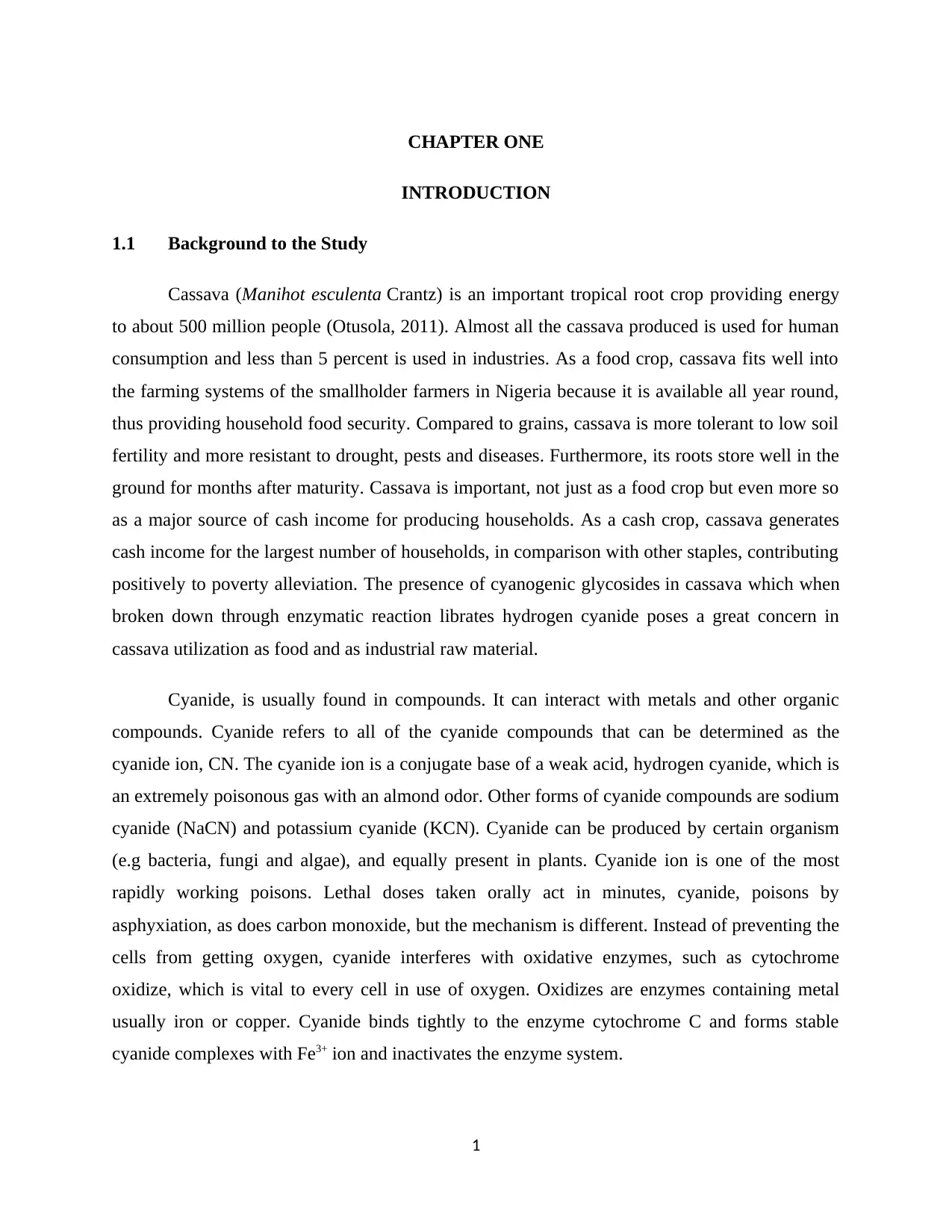
CHAPTER ONE
INTRODUCTION
1.1 Background to the Study
Cassava (Manihot esculenta Crantz) is an important tropical root crop providing energy
to about 500 million people (Otusola, 2011). Almost all the cassava produced is used for human
consumption and less than 5 percent is used in industries. As a food crop, cassava fits well into
the farming systems of the smallholder farmers in Nigeria because it is available all year round,
thus providing household food security. Compared to grains, cassava is more tolerant to low soil
fertility and more resistant to drought, pests and diseases. Furthermore, its roots store well in the
ground for months after maturity. Cassava is important, not just as a food crop but even more so
as a major source of cash income for producing households. As a cash crop, cassava generates
cash income for the largest number of households, in comparison with other staples, contributing
positively to poverty alleviation. The presence of cyanogenic glycosides in cassava which when
broken down through enzymatic reaction librates hydrogen cyanide poses a great concern in
cassava utilization as food and as industrial raw material.
Cyanide, is usually found in compounds. It can interact with metals and other organic
compounds. Cyanide refers to all of the cyanide compounds that can be determined as the
cyanide ion, CN. The cyanide ion is a conjugate base of a weak acid, hydrogen cyanide, which is
an extremely poisonous gas with an almond odor. Other forms of cyanide compounds are sodium
cyanide (NaCN) and potassium cyanide (KCN). Cyanide can be produced by certain organism
(e.g bacteria, fungi and algae), and equally present in plants. Cyanide ion is one of the most
rapidly working poisons. Lethal doses taken orally act in minutes, cyanide, poisons by
asphyxiation, as does carbon monoxide, but the mechanism is different. Instead of preventing the
cells from getting oxygen, cyanide interferes with oxidative enzymes, such as cytochrome
oxidize, which is vital to every cell in use of oxygen. Oxidizes are enzymes containing metal
usually iron or copper. Cyanide binds tightly to the enzyme cytochrome C and forms stable
cyanide complexes with Fe3+ ion and inactivates the enzyme system.
1
INTRODUCTION
1.1 Background to the Study
Cassava (Manihot esculenta Crantz) is an important tropical root crop providing energy
to about 500 million people (Otusola, 2011). Almost all the cassava produced is used for human
consumption and less than 5 percent is used in industries. As a food crop, cassava fits well into
the farming systems of the smallholder farmers in Nigeria because it is available all year round,
thus providing household food security. Compared to grains, cassava is more tolerant to low soil
fertility and more resistant to drought, pests and diseases. Furthermore, its roots store well in the
ground for months after maturity. Cassava is important, not just as a food crop but even more so
as a major source of cash income for producing households. As a cash crop, cassava generates
cash income for the largest number of households, in comparison with other staples, contributing
positively to poverty alleviation. The presence of cyanogenic glycosides in cassava which when
broken down through enzymatic reaction librates hydrogen cyanide poses a great concern in
cassava utilization as food and as industrial raw material.
Cyanide, is usually found in compounds. It can interact with metals and other organic
compounds. Cyanide refers to all of the cyanide compounds that can be determined as the
cyanide ion, CN. The cyanide ion is a conjugate base of a weak acid, hydrogen cyanide, which is
an extremely poisonous gas with an almond odor. Other forms of cyanide compounds are sodium
cyanide (NaCN) and potassium cyanide (KCN). Cyanide can be produced by certain organism
(e.g bacteria, fungi and algae), and equally present in plants. Cyanide ion is one of the most
rapidly working poisons. Lethal doses taken orally act in minutes, cyanide, poisons by
asphyxiation, as does carbon monoxide, but the mechanism is different. Instead of preventing the
cells from getting oxygen, cyanide interferes with oxidative enzymes, such as cytochrome
oxidize, which is vital to every cell in use of oxygen. Oxidizes are enzymes containing metal
usually iron or copper. Cyanide binds tightly to the enzyme cytochrome C and forms stable
cyanide complexes with Fe3+ ion and inactivates the enzyme system.
1
Paraphrase This Document
Need a fresh take? Get an instant paraphrase of this document with our AI Paraphraser
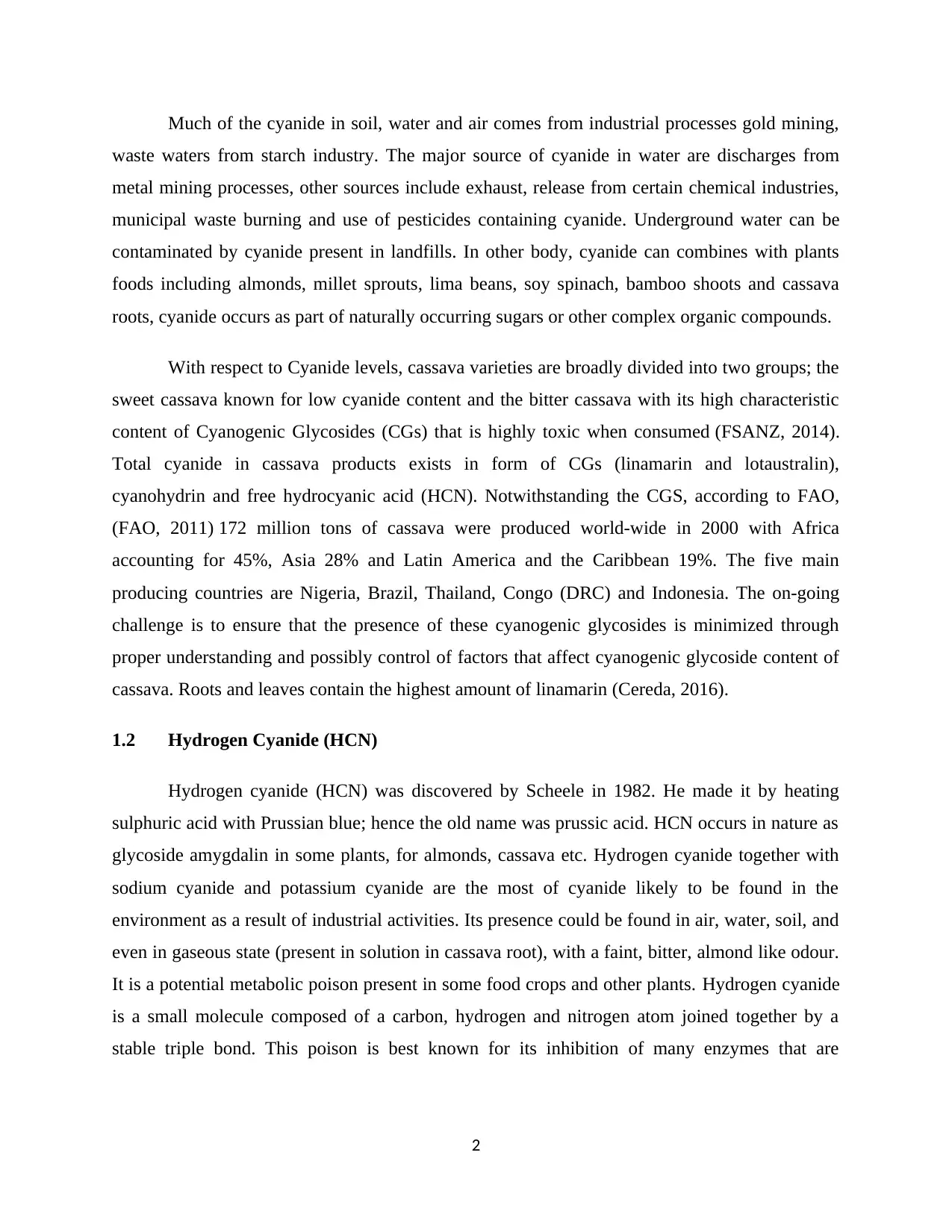
Much of the cyanide in soil, water and air comes from industrial processes gold mining,
waste waters from starch industry. The major source of cyanide in water are discharges from
metal mining processes, other sources include exhaust, release from certain chemical industries,
municipal waste burning and use of pesticides containing cyanide. Underground water can be
contaminated by cyanide present in landfills. In other body, cyanide can combines with plants
foods including almonds, millet sprouts, lima beans, soy spinach, bamboo shoots and cassava
roots, cyanide occurs as part of naturally occurring sugars or other complex organic compounds.
With respect to Cyanide levels, cassava varieties are broadly divided into two groups; the
sweet cassava known for low cyanide content and the bitter cassava with its high characteristic
content of Cyanogenic Glycosides (CGs) that is highly toxic when consumed (FSANZ, 2014).
Total cyanide in cassava products exists in form of CGs (linamarin and lotaustralin),
cyanohydrin and free hydrocyanic acid (HCN). Notwithstanding the CGS, according to FAO,
(FAO, 2011) 172 million tons of cassava were produced world-wide in 2000 with Africa
accounting for 45%, Asia 28% and Latin America and the Caribbean 19%. The five main
producing countries are Nigeria, Brazil, Thailand, Congo (DRC) and Indonesia. The on-going
challenge is to ensure that the presence of these cyanogenic glycosides is minimized through
proper understanding and possibly control of factors that affect cyanogenic glycoside content of
cassava. Roots and leaves contain the highest amount of linamarin (Cereda, 2016).
1.2 Hydrogen Cyanide (HCN)
Hydrogen cyanide (HCN) was discovered by Scheele in 1982. He made it by heating
sulphuric acid with Prussian blue; hence the old name was prussic acid. HCN occurs in nature as
glycoside amygdalin in some plants, for almonds, cassava etc. Hydrogen cyanide together with
sodium cyanide and potassium cyanide are the most of cyanide likely to be found in the
environment as a result of industrial activities. Its presence could be found in air, water, soil, and
even in gaseous state (present in solution in cassava root), with a faint, bitter, almond like odour.
It is a potential metabolic poison present in some food crops and other plants. Hydrogen cyanide
is a small molecule composed of a carbon, hydrogen and nitrogen atom joined together by a
stable triple bond. This poison is best known for its inhibition of many enzymes that are
2
waste waters from starch industry. The major source of cyanide in water are discharges from
metal mining processes, other sources include exhaust, release from certain chemical industries,
municipal waste burning and use of pesticides containing cyanide. Underground water can be
contaminated by cyanide present in landfills. In other body, cyanide can combines with plants
foods including almonds, millet sprouts, lima beans, soy spinach, bamboo shoots and cassava
roots, cyanide occurs as part of naturally occurring sugars or other complex organic compounds.
With respect to Cyanide levels, cassava varieties are broadly divided into two groups; the
sweet cassava known for low cyanide content and the bitter cassava with its high characteristic
content of Cyanogenic Glycosides (CGs) that is highly toxic when consumed (FSANZ, 2014).
Total cyanide in cassava products exists in form of CGs (linamarin and lotaustralin),
cyanohydrin and free hydrocyanic acid (HCN). Notwithstanding the CGS, according to FAO,
(FAO, 2011) 172 million tons of cassava were produced world-wide in 2000 with Africa
accounting for 45%, Asia 28% and Latin America and the Caribbean 19%. The five main
producing countries are Nigeria, Brazil, Thailand, Congo (DRC) and Indonesia. The on-going
challenge is to ensure that the presence of these cyanogenic glycosides is minimized through
proper understanding and possibly control of factors that affect cyanogenic glycoside content of
cassava. Roots and leaves contain the highest amount of linamarin (Cereda, 2016).
1.2 Hydrogen Cyanide (HCN)
Hydrogen cyanide (HCN) was discovered by Scheele in 1982. He made it by heating
sulphuric acid with Prussian blue; hence the old name was prussic acid. HCN occurs in nature as
glycoside amygdalin in some plants, for almonds, cassava etc. Hydrogen cyanide together with
sodium cyanide and potassium cyanide are the most of cyanide likely to be found in the
environment as a result of industrial activities. Its presence could be found in air, water, soil, and
even in gaseous state (present in solution in cassava root), with a faint, bitter, almond like odour.
It is a potential metabolic poison present in some food crops and other plants. Hydrogen cyanide
is a small molecule composed of a carbon, hydrogen and nitrogen atom joined together by a
stable triple bond. This poison is best known for its inhibition of many enzymes that are
2
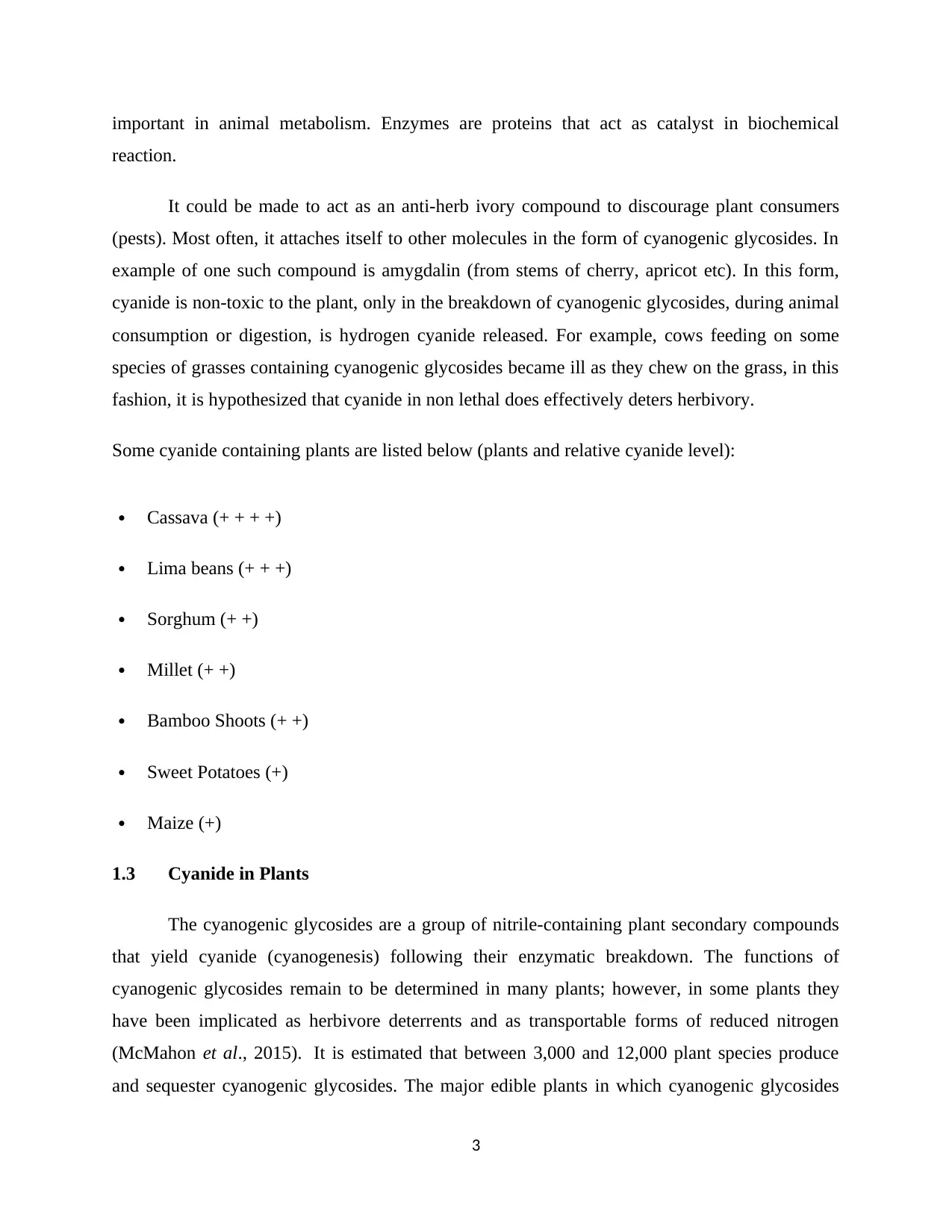
important in animal metabolism. Enzymes are proteins that act as catalyst in biochemical
reaction.
It could be made to act as an anti-herb ivory compound to discourage plant consumers
(pests). Most often, it attaches itself to other molecules in the form of cyanogenic glycosides. In
example of one such compound is amygdalin (from stems of cherry, apricot etc). In this form,
cyanide is non-toxic to the plant, only in the breakdown of cyanogenic glycosides, during animal
consumption or digestion, is hydrogen cyanide released. For example, cows feeding on some
species of grasses containing cyanogenic glycosides became ill as they chew on the grass, in this
fashion, it is hypothesized that cyanide in non lethal does effectively deters herbivory.
Some cyanide containing plants are listed below (plants and relative cyanide level):
Cassava (+ + + +)
Lima beans (+ + +)
Sorghum (+ +)
Millet (+ +)
Bamboo Shoots (+ +)
Sweet Potatoes (+)
Maize (+)
1.3 Cyanide in Plants
The cyanogenic glycosides are a group of nitrile-containing plant secondary compounds
that yield cyanide (cyanogenesis) following their enzymatic breakdown. The functions of
cyanogenic glycosides remain to be determined in many plants; however, in some plants they
have been implicated as herbivore deterrents and as transportable forms of reduced nitrogen
(McMahon et al., 2015). It is estimated that between 3,000 and 12,000 plant species produce
and sequester cyanogenic glycosides. The major edible plants in which cyanogenic glycosides
3
reaction.
It could be made to act as an anti-herb ivory compound to discourage plant consumers
(pests). Most often, it attaches itself to other molecules in the form of cyanogenic glycosides. In
example of one such compound is amygdalin (from stems of cherry, apricot etc). In this form,
cyanide is non-toxic to the plant, only in the breakdown of cyanogenic glycosides, during animal
consumption or digestion, is hydrogen cyanide released. For example, cows feeding on some
species of grasses containing cyanogenic glycosides became ill as they chew on the grass, in this
fashion, it is hypothesized that cyanide in non lethal does effectively deters herbivory.
Some cyanide containing plants are listed below (plants and relative cyanide level):
Cassava (+ + + +)
Lima beans (+ + +)
Sorghum (+ +)
Millet (+ +)
Bamboo Shoots (+ +)
Sweet Potatoes (+)
Maize (+)
1.3 Cyanide in Plants
The cyanogenic glycosides are a group of nitrile-containing plant secondary compounds
that yield cyanide (cyanogenesis) following their enzymatic breakdown. The functions of
cyanogenic glycosides remain to be determined in many plants; however, in some plants they
have been implicated as herbivore deterrents and as transportable forms of reduced nitrogen
(McMahon et al., 2015). It is estimated that between 3,000 and 12,000 plant species produce
and sequester cyanogenic glycosides. The major edible plants in which cyanogenic glycosides
3
You're viewing a preview
Unlock full access by subscribing today!
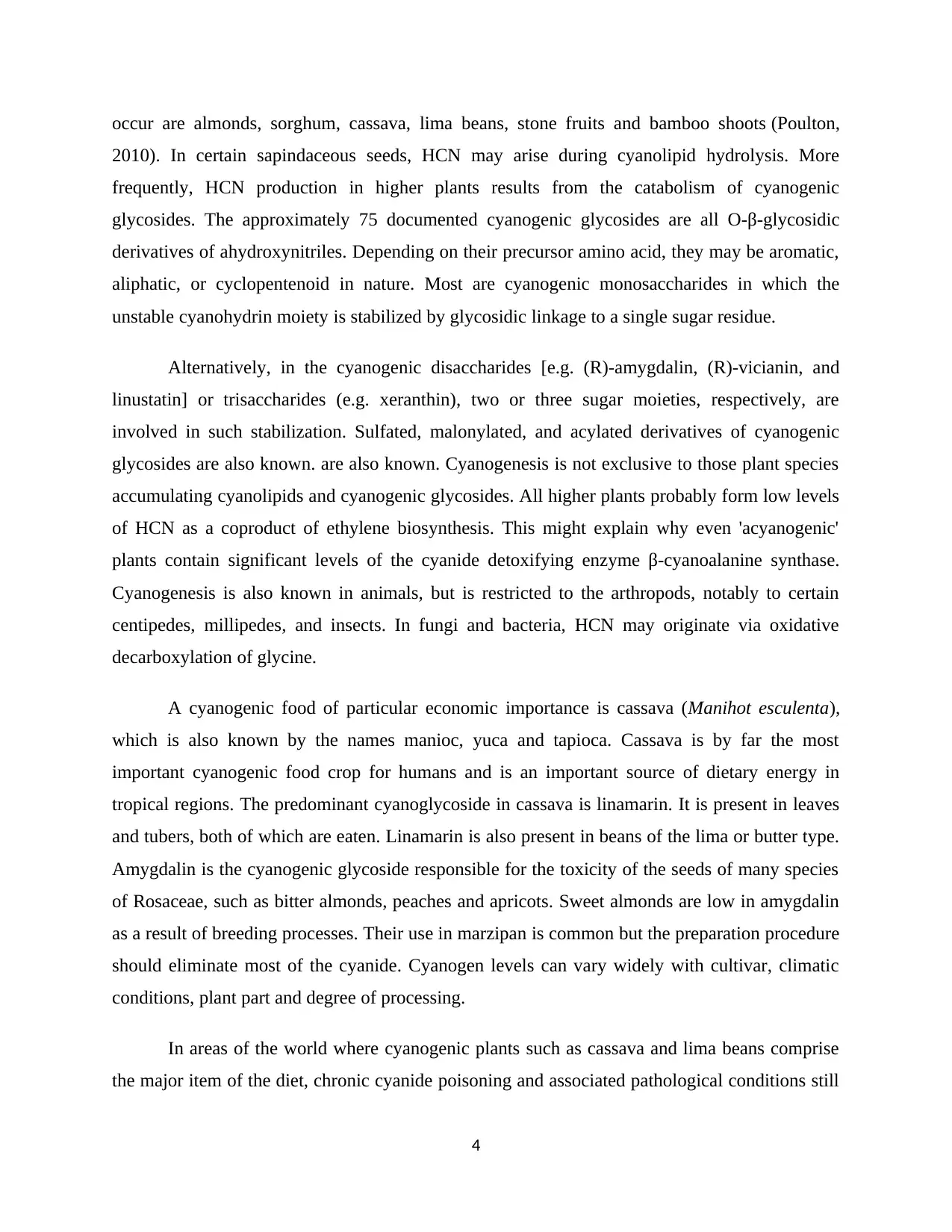
occur are almonds, sorghum, cassava, lima beans, stone fruits and bamboo shoots (Poulton,
2010). In certain sapindaceous seeds, HCN may arise during cyanolipid hydrolysis. More
frequently, HCN production in higher plants results from the catabolism of cyanogenic
glycosides. The approximately 75 documented cyanogenic glycosides are all O-β-glycosidic
derivatives of ahydroxynitriles. Depending on their precursor amino acid, they may be aromatic,
aliphatic, or cyclopentenoid in nature. Most are cyanogenic monosaccharides in which the
unstable cyanohydrin moiety is stabilized by glycosidic linkage to a single sugar residue.
Alternatively, in the cyanogenic disaccharides [e.g. (R)-amygdalin, (R)-vicianin, and
linustatin] or trisaccharides (e.g. xeranthin), two or three sugar moieties, respectively, are
involved in such stabilization. Sulfated, malonylated, and acylated derivatives of cyanogenic
glycosides are also known. are also known. Cyanogenesis is not exclusive to those plant species
accumulating cyanolipids and cyanogenic glycosides. All higher plants probably form low levels
of HCN as a coproduct of ethylene biosynthesis. This might explain why even 'acyanogenic'
plants contain significant levels of the cyanide detoxifying enzyme β-cyanoalanine synthase.
Cyanogenesis is also known in animals, but is restricted to the arthropods, notably to certain
centipedes, millipedes, and insects. In fungi and bacteria, HCN may originate via oxidative
decarboxylation of glycine.
A cyanogenic food of particular economic importance is cassava (Manihot esculenta),
which is also known by the names manioc, yuca and tapioca. Cassava is by far the most
important cyanogenic food crop for humans and is an important source of dietary energy in
tropical regions. The predominant cyanoglycoside in cassava is linamarin. It is present in leaves
and tubers, both of which are eaten. Linamarin is also present in beans of the lima or butter type.
Amygdalin is the cyanogenic glycoside responsible for the toxicity of the seeds of many species
of Rosaceae, such as bitter almonds, peaches and apricots. Sweet almonds are low in amygdalin
as a result of breeding processes. Their use in marzipan is common but the preparation procedure
should eliminate most of the cyanide. Cyanogen levels can vary widely with cultivar, climatic
conditions, plant part and degree of processing.
In areas of the world where cyanogenic plants such as cassava and lima beans comprise
the major item of the diet, chronic cyanide poisoning and associated pathological conditions still
4
2010). In certain sapindaceous seeds, HCN may arise during cyanolipid hydrolysis. More
frequently, HCN production in higher plants results from the catabolism of cyanogenic
glycosides. The approximately 75 documented cyanogenic glycosides are all O-β-glycosidic
derivatives of ahydroxynitriles. Depending on their precursor amino acid, they may be aromatic,
aliphatic, or cyclopentenoid in nature. Most are cyanogenic monosaccharides in which the
unstable cyanohydrin moiety is stabilized by glycosidic linkage to a single sugar residue.
Alternatively, in the cyanogenic disaccharides [e.g. (R)-amygdalin, (R)-vicianin, and
linustatin] or trisaccharides (e.g. xeranthin), two or three sugar moieties, respectively, are
involved in such stabilization. Sulfated, malonylated, and acylated derivatives of cyanogenic
glycosides are also known. are also known. Cyanogenesis is not exclusive to those plant species
accumulating cyanolipids and cyanogenic glycosides. All higher plants probably form low levels
of HCN as a coproduct of ethylene biosynthesis. This might explain why even 'acyanogenic'
plants contain significant levels of the cyanide detoxifying enzyme β-cyanoalanine synthase.
Cyanogenesis is also known in animals, but is restricted to the arthropods, notably to certain
centipedes, millipedes, and insects. In fungi and bacteria, HCN may originate via oxidative
decarboxylation of glycine.
A cyanogenic food of particular economic importance is cassava (Manihot esculenta),
which is also known by the names manioc, yuca and tapioca. Cassava is by far the most
important cyanogenic food crop for humans and is an important source of dietary energy in
tropical regions. The predominant cyanoglycoside in cassava is linamarin. It is present in leaves
and tubers, both of which are eaten. Linamarin is also present in beans of the lima or butter type.
Amygdalin is the cyanogenic glycoside responsible for the toxicity of the seeds of many species
of Rosaceae, such as bitter almonds, peaches and apricots. Sweet almonds are low in amygdalin
as a result of breeding processes. Their use in marzipan is common but the preparation procedure
should eliminate most of the cyanide. Cyanogen levels can vary widely with cultivar, climatic
conditions, plant part and degree of processing.
In areas of the world where cyanogenic plants such as cassava and lima beans comprise
the major item of the diet, chronic cyanide poisoning and associated pathological conditions still
4
Paraphrase This Document
Need a fresh take? Get an instant paraphrase of this document with our AI Paraphraser
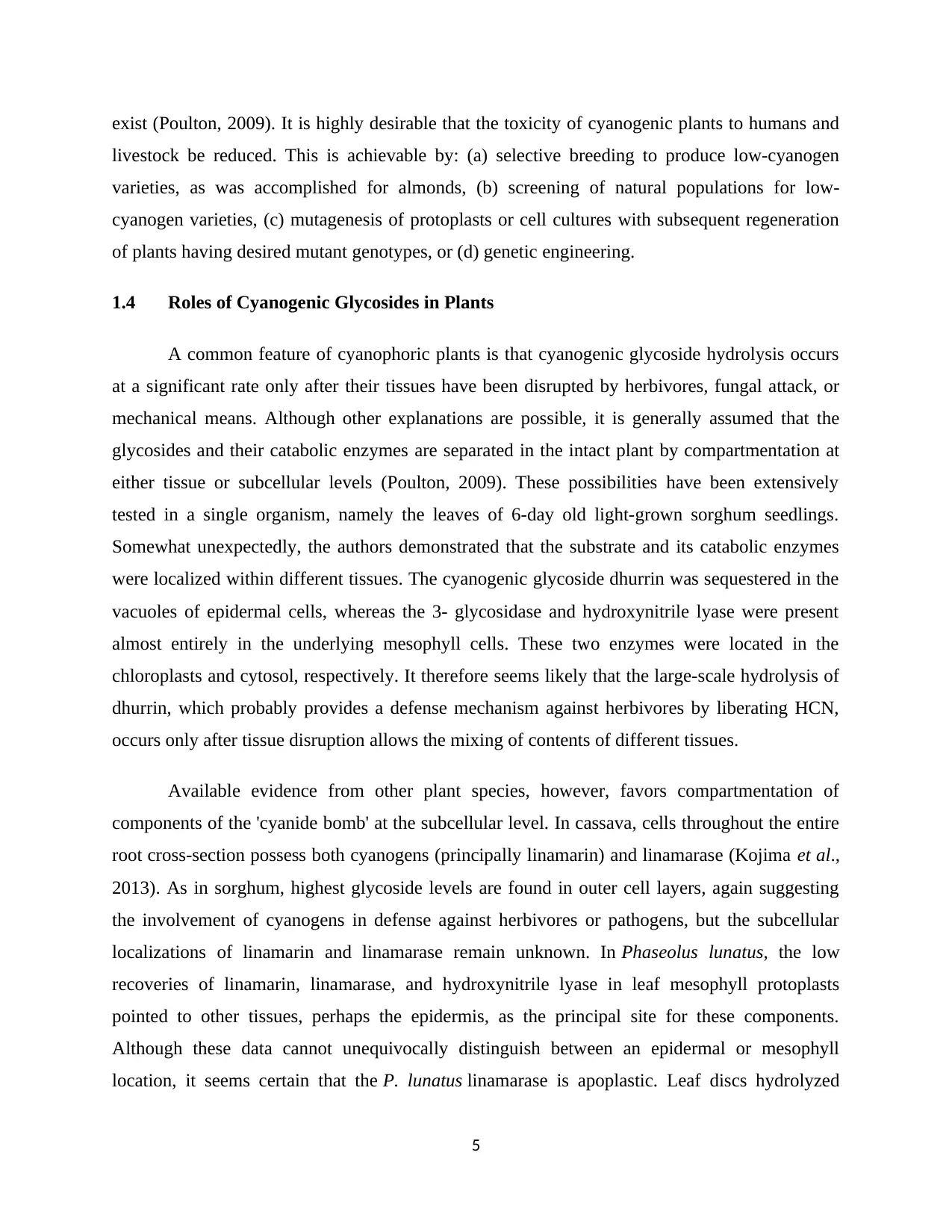
exist (Poulton, 2009). It is highly desirable that the toxicity of cyanogenic plants to humans and
livestock be reduced. This is achievable by: (a) selective breeding to produce low-cyanogen
varieties, as was accomplished for almonds, (b) screening of natural populations for low-
cyanogen varieties, (c) mutagenesis of protoplasts or cell cultures with subsequent regeneration
of plants having desired mutant genotypes, or (d) genetic engineering.
1.4 Roles of Cyanogenic Glycosides in Plants
A common feature of cyanophoric plants is that cyanogenic glycoside hydrolysis occurs
at a significant rate only after their tissues have been disrupted by herbivores, fungal attack, or
mechanical means. Although other explanations are possible, it is generally assumed that the
glycosides and their catabolic enzymes are separated in the intact plant by compartmentation at
either tissue or subcellular levels (Poulton, 2009). These possibilities have been extensively
tested in a single organism, namely the leaves of 6-day old light-grown sorghum seedlings.
Somewhat unexpectedly, the authors demonstrated that the substrate and its catabolic enzymes
were localized within different tissues. The cyanogenic glycoside dhurrin was sequestered in the
vacuoles of epidermal cells, whereas the 3- glycosidase and hydroxynitrile lyase were present
almost entirely in the underlying mesophyll cells. These two enzymes were located in the
chloroplasts and cytosol, respectively. It therefore seems likely that the large-scale hydrolysis of
dhurrin, which probably provides a defense mechanism against herbivores by liberating HCN,
occurs only after tissue disruption allows the mixing of contents of different tissues.
Available evidence from other plant species, however, favors compartmentation of
components of the 'cyanide bomb' at the subcellular level. In cassava, cells throughout the entire
root cross-section possess both cyanogens (principally linamarin) and linamarase (Kojima et al.,
2013). As in sorghum, highest glycoside levels are found in outer cell layers, again suggesting
the involvement of cyanogens in defense against herbivores or pathogens, but the subcellular
localizations of linamarin and linamarase remain unknown. In Phaseolus lunatus, the low
recoveries of linamarin, linamarase, and hydroxynitrile lyase in leaf mesophyll protoplasts
pointed to other tissues, perhaps the epidermis, as the principal site for these components.
Although these data cannot unequivocally distinguish between an epidermal or mesophyll
location, it seems certain that the P. lunatus linamarase is apoplastic. Leaf discs hydrolyzed
5
livestock be reduced. This is achievable by: (a) selective breeding to produce low-cyanogen
varieties, as was accomplished for almonds, (b) screening of natural populations for low-
cyanogen varieties, (c) mutagenesis of protoplasts or cell cultures with subsequent regeneration
of plants having desired mutant genotypes, or (d) genetic engineering.
1.4 Roles of Cyanogenic Glycosides in Plants
A common feature of cyanophoric plants is that cyanogenic glycoside hydrolysis occurs
at a significant rate only after their tissues have been disrupted by herbivores, fungal attack, or
mechanical means. Although other explanations are possible, it is generally assumed that the
glycosides and their catabolic enzymes are separated in the intact plant by compartmentation at
either tissue or subcellular levels (Poulton, 2009). These possibilities have been extensively
tested in a single organism, namely the leaves of 6-day old light-grown sorghum seedlings.
Somewhat unexpectedly, the authors demonstrated that the substrate and its catabolic enzymes
were localized within different tissues. The cyanogenic glycoside dhurrin was sequestered in the
vacuoles of epidermal cells, whereas the 3- glycosidase and hydroxynitrile lyase were present
almost entirely in the underlying mesophyll cells. These two enzymes were located in the
chloroplasts and cytosol, respectively. It therefore seems likely that the large-scale hydrolysis of
dhurrin, which probably provides a defense mechanism against herbivores by liberating HCN,
occurs only after tissue disruption allows the mixing of contents of different tissues.
Available evidence from other plant species, however, favors compartmentation of
components of the 'cyanide bomb' at the subcellular level. In cassava, cells throughout the entire
root cross-section possess both cyanogens (principally linamarin) and linamarase (Kojima et al.,
2013). As in sorghum, highest glycoside levels are found in outer cell layers, again suggesting
the involvement of cyanogens in defense against herbivores or pathogens, but the subcellular
localizations of linamarin and linamarase remain unknown. In Phaseolus lunatus, the low
recoveries of linamarin, linamarase, and hydroxynitrile lyase in leaf mesophyll protoplasts
pointed to other tissues, perhaps the epidermis, as the principal site for these components.
Although these data cannot unequivocally distinguish between an epidermal or mesophyll
location, it seems certain that the P. lunatus linamarase is apoplastic. Leaf discs hydrolyzed
5
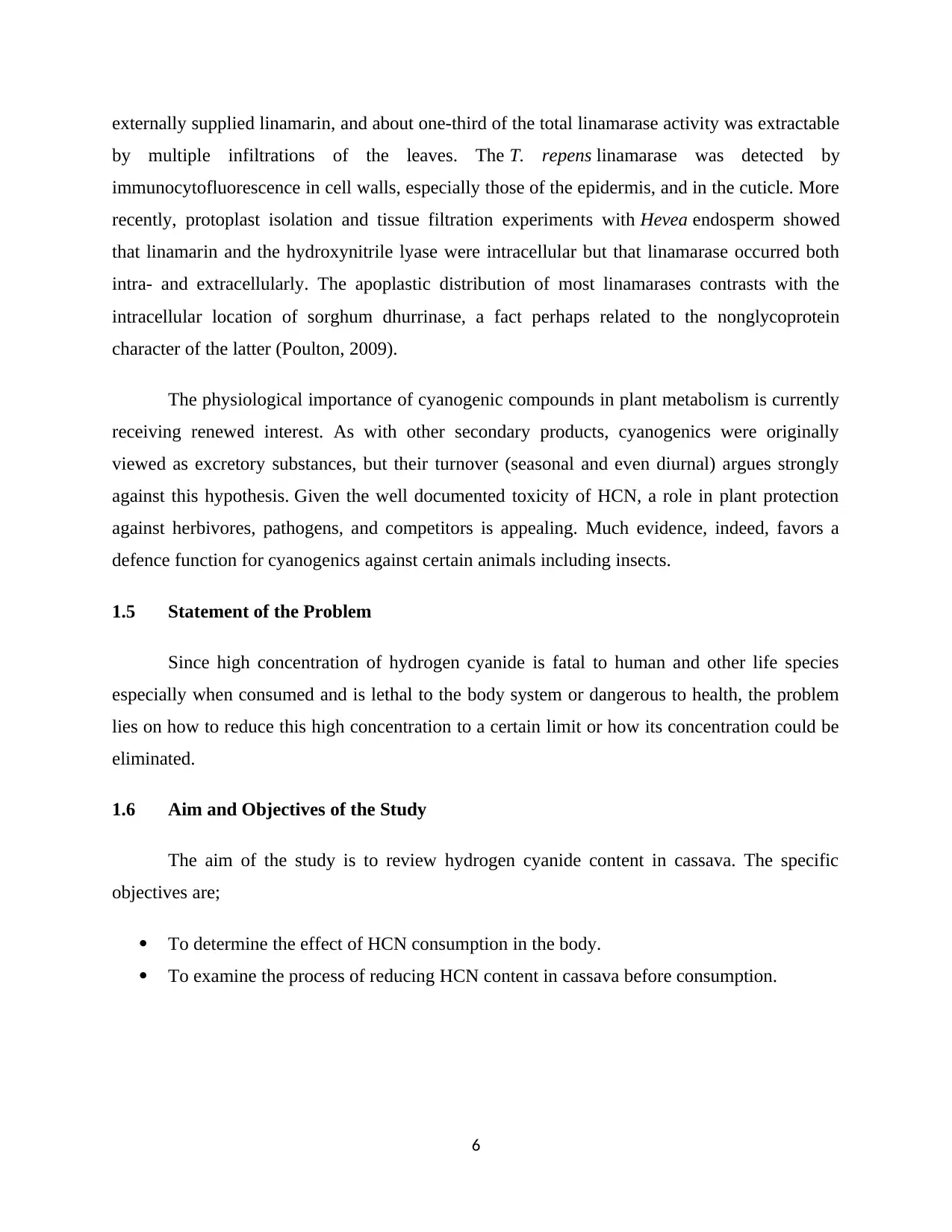
externally supplied linamarin, and about one-third of the total linamarase activity was extractable
by multiple infiltrations of the leaves. The T. repens linamarase was detected by
immunocytofluorescence in cell walls, especially those of the epidermis, and in the cuticle. More
recently, protoplast isolation and tissue filtration experiments with Hevea endosperm showed
that linamarin and the hydroxynitrile lyase were intracellular but that linamarase occurred both
intra- and extracellularly. The apoplastic distribution of most linamarases contrasts with the
intracellular location of sorghum dhurrinase, a fact perhaps related to the nonglycoprotein
character of the latter (Poulton, 2009).
The physiological importance of cyanogenic compounds in plant metabolism is currently
receiving renewed interest. As with other secondary products, cyanogenics were originally
viewed as excretory substances, but their turnover (seasonal and even diurnal) argues strongly
against this hypothesis. Given the well documented toxicity of HCN, a role in plant protection
against herbivores, pathogens, and competitors is appealing. Much evidence, indeed, favors a
defence function for cyanogenics against certain animals including insects.
1.5 Statement of the Problem
Since high concentration of hydrogen cyanide is fatal to human and other life species
especially when consumed and is lethal to the body system or dangerous to health, the problem
lies on how to reduce this high concentration to a certain limit or how its concentration could be
eliminated.
1.6 Aim and Objectives of the Study
The aim of the study is to review hydrogen cyanide content in cassava. The specific
objectives are;
To determine the effect of HCN consumption in the body.
To examine the process of reducing HCN content in cassava before consumption.
6
by multiple infiltrations of the leaves. The T. repens linamarase was detected by
immunocytofluorescence in cell walls, especially those of the epidermis, and in the cuticle. More
recently, protoplast isolation and tissue filtration experiments with Hevea endosperm showed
that linamarin and the hydroxynitrile lyase were intracellular but that linamarase occurred both
intra- and extracellularly. The apoplastic distribution of most linamarases contrasts with the
intracellular location of sorghum dhurrinase, a fact perhaps related to the nonglycoprotein
character of the latter (Poulton, 2009).
The physiological importance of cyanogenic compounds in plant metabolism is currently
receiving renewed interest. As with other secondary products, cyanogenics were originally
viewed as excretory substances, but their turnover (seasonal and even diurnal) argues strongly
against this hypothesis. Given the well documented toxicity of HCN, a role in plant protection
against herbivores, pathogens, and competitors is appealing. Much evidence, indeed, favors a
defence function for cyanogenics against certain animals including insects.
1.5 Statement of the Problem
Since high concentration of hydrogen cyanide is fatal to human and other life species
especially when consumed and is lethal to the body system or dangerous to health, the problem
lies on how to reduce this high concentration to a certain limit or how its concentration could be
eliminated.
1.6 Aim and Objectives of the Study
The aim of the study is to review hydrogen cyanide content in cassava. The specific
objectives are;
To determine the effect of HCN consumption in the body.
To examine the process of reducing HCN content in cassava before consumption.
6
You're viewing a preview
Unlock full access by subscribing today!
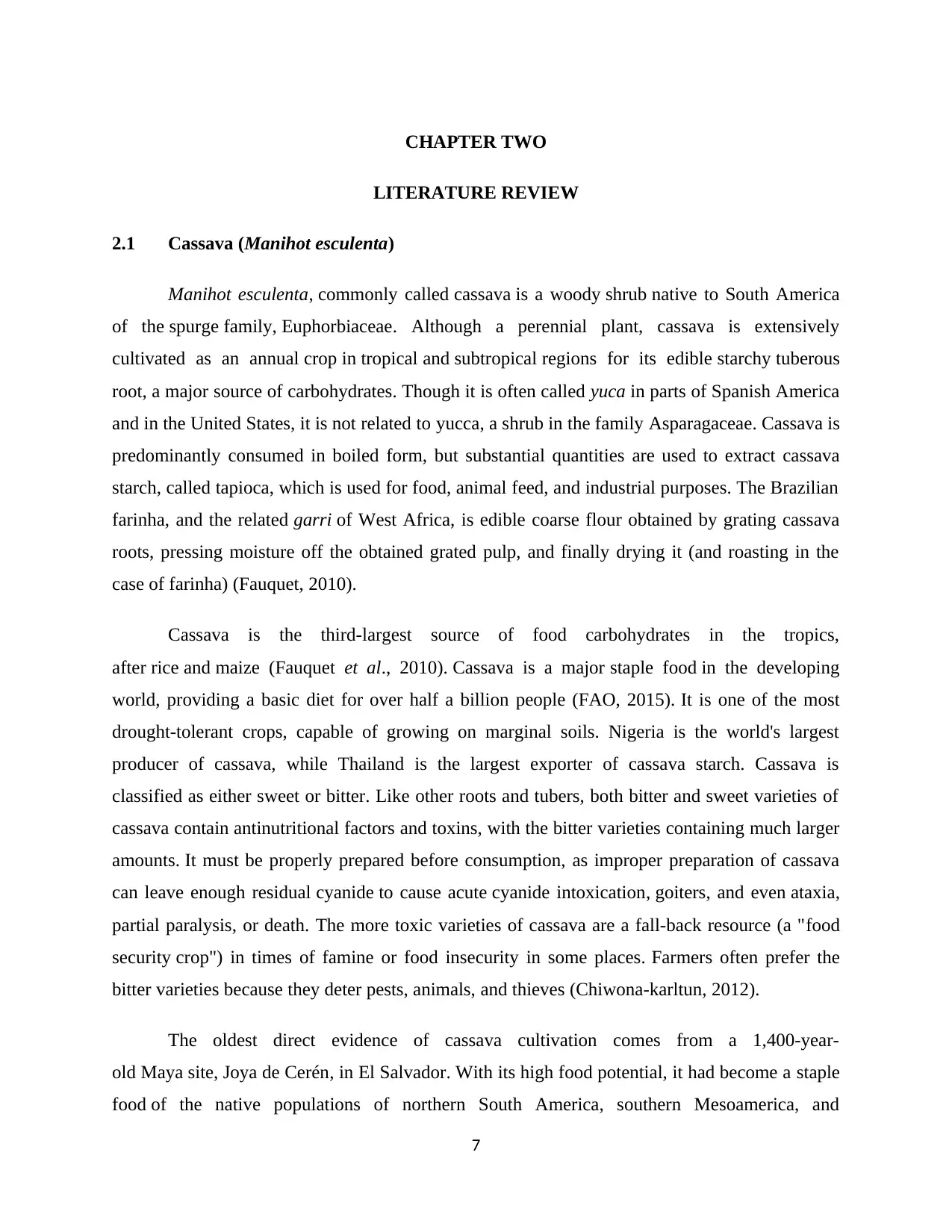
CHAPTER TWO
LITERATURE REVIEW
2.1 Cassava (Manihot esculenta)
Manihot esculenta, commonly called cassava is a woody shrub native to South America
of the spurge family, Euphorbiaceae. Although a perennial plant, cassava is extensively
cultivated as an annual crop in tropical and subtropical regions for its edible starchy tuberous
root, a major source of carbohydrates. Though it is often called yuca in parts of Spanish America
and in the United States, it is not related to yucca, a shrub in the family Asparagaceae. Cassava is
predominantly consumed in boiled form, but substantial quantities are used to extract cassava
starch, called tapioca, which is used for food, animal feed, and industrial purposes. The Brazilian
farinha, and the related garri of West Africa, is edible coarse flour obtained by grating cassava
roots, pressing moisture off the obtained grated pulp, and finally drying it (and roasting in the
case of farinha) (Fauquet, 2010).
Cassava is the third-largest source of food carbohydrates in the tropics,
after rice and maize (Fauquet et al., 2010). Cassava is a major staple food in the developing
world, providing a basic diet for over half a billion people (FAO, 2015). It is one of the most
drought-tolerant crops, capable of growing on marginal soils. Nigeria is the world's largest
producer of cassava, while Thailand is the largest exporter of cassava starch. Cassava is
classified as either sweet or bitter. Like other roots and tubers, both bitter and sweet varieties of
cassava contain antinutritional factors and toxins, with the bitter varieties containing much larger
amounts. It must be properly prepared before consumption, as improper preparation of cassava
can leave enough residual cyanide to cause acute cyanide intoxication, goiters, and even ataxia,
partial paralysis, or death. The more toxic varieties of cassava are a fall-back resource (a "food
security crop") in times of famine or food insecurity in some places. Farmers often prefer the
bitter varieties because they deter pests, animals, and thieves (Chiwona-karltun, 2012).
The oldest direct evidence of cassava cultivation comes from a 1,400-year-
old Maya site, Joya de Cerén, in El Salvador. With its high food potential, it had become a staple
food of the native populations of northern South America, southern Mesoamerica, and
7
LITERATURE REVIEW
2.1 Cassava (Manihot esculenta)
Manihot esculenta, commonly called cassava is a woody shrub native to South America
of the spurge family, Euphorbiaceae. Although a perennial plant, cassava is extensively
cultivated as an annual crop in tropical and subtropical regions for its edible starchy tuberous
root, a major source of carbohydrates. Though it is often called yuca in parts of Spanish America
and in the United States, it is not related to yucca, a shrub in the family Asparagaceae. Cassava is
predominantly consumed in boiled form, but substantial quantities are used to extract cassava
starch, called tapioca, which is used for food, animal feed, and industrial purposes. The Brazilian
farinha, and the related garri of West Africa, is edible coarse flour obtained by grating cassava
roots, pressing moisture off the obtained grated pulp, and finally drying it (and roasting in the
case of farinha) (Fauquet, 2010).
Cassava is the third-largest source of food carbohydrates in the tropics,
after rice and maize (Fauquet et al., 2010). Cassava is a major staple food in the developing
world, providing a basic diet for over half a billion people (FAO, 2015). It is one of the most
drought-tolerant crops, capable of growing on marginal soils. Nigeria is the world's largest
producer of cassava, while Thailand is the largest exporter of cassava starch. Cassava is
classified as either sweet or bitter. Like other roots and tubers, both bitter and sweet varieties of
cassava contain antinutritional factors and toxins, with the bitter varieties containing much larger
amounts. It must be properly prepared before consumption, as improper preparation of cassava
can leave enough residual cyanide to cause acute cyanide intoxication, goiters, and even ataxia,
partial paralysis, or death. The more toxic varieties of cassava are a fall-back resource (a "food
security crop") in times of famine or food insecurity in some places. Farmers often prefer the
bitter varieties because they deter pests, animals, and thieves (Chiwona-karltun, 2012).
The oldest direct evidence of cassava cultivation comes from a 1,400-year-
old Maya site, Joya de Cerén, in El Salvador. With its high food potential, it had become a staple
food of the native populations of northern South America, southern Mesoamerica, and
7
Paraphrase This Document
Need a fresh take? Get an instant paraphrase of this document with our AI Paraphraser
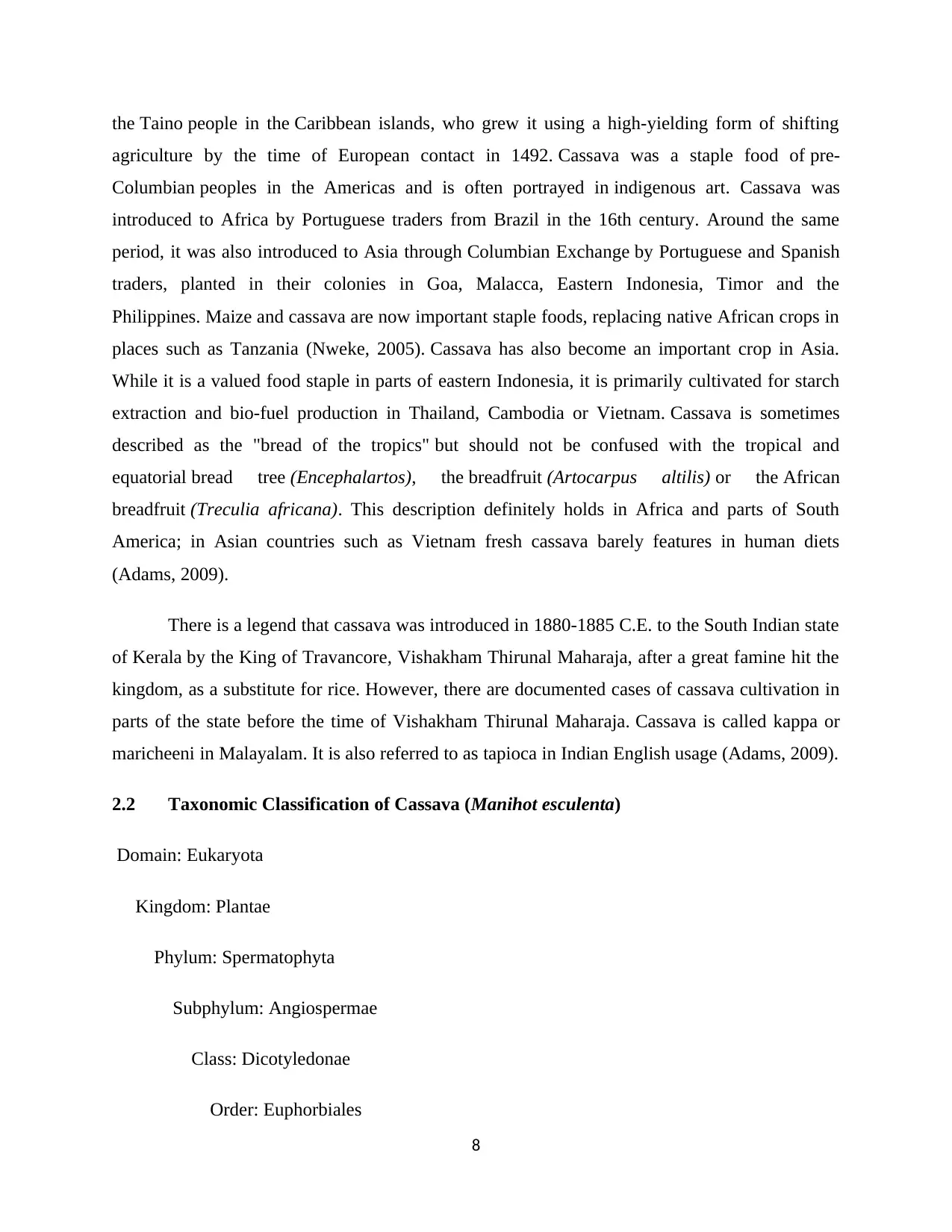
the Taino people in the Caribbean islands, who grew it using a high-yielding form of shifting
agriculture by the time of European contact in 1492. Cassava was a staple food of pre-
Columbian peoples in the Americas and is often portrayed in indigenous art. Cassava was
introduced to Africa by Portuguese traders from Brazil in the 16th century. Around the same
period, it was also introduced to Asia through Columbian Exchange by Portuguese and Spanish
traders, planted in their colonies in Goa, Malacca, Eastern Indonesia, Timor and the
Philippines. Maize and cassava are now important staple foods, replacing native African crops in
places such as Tanzania (Nweke, 2005). Cassava has also become an important crop in Asia.
While it is a valued food staple in parts of eastern Indonesia, it is primarily cultivated for starch
extraction and bio-fuel production in Thailand, Cambodia or Vietnam. Cassava is sometimes
described as the "bread of the tropics" but should not be confused with the tropical and
equatorial bread tree (Encephalartos), the breadfruit (Artocarpus altilis) or the African
breadfruit (Treculia africana). This description definitely holds in Africa and parts of South
America; in Asian countries such as Vietnam fresh cassava barely features in human diets
(Adams, 2009).
There is a legend that cassava was introduced in 1880-1885 C.E. to the South Indian state
of Kerala by the King of Travancore, Vishakham Thirunal Maharaja, after a great famine hit the
kingdom, as a substitute for rice. However, there are documented cases of cassava cultivation in
parts of the state before the time of Vishakham Thirunal Maharaja. Cassava is called kappa or
maricheeni in Malayalam. It is also referred to as tapioca in Indian English usage (Adams, 2009).
2.2 Taxonomic Classification of Cassava (Manihot esculenta)
Domain: Eukaryota
Kingdom: Plantae
Phylum: Spermatophyta
Subphylum: Angiospermae
Class: Dicotyledonae
Order: Euphorbiales
8
agriculture by the time of European contact in 1492. Cassava was a staple food of pre-
Columbian peoples in the Americas and is often portrayed in indigenous art. Cassava was
introduced to Africa by Portuguese traders from Brazil in the 16th century. Around the same
period, it was also introduced to Asia through Columbian Exchange by Portuguese and Spanish
traders, planted in their colonies in Goa, Malacca, Eastern Indonesia, Timor and the
Philippines. Maize and cassava are now important staple foods, replacing native African crops in
places such as Tanzania (Nweke, 2005). Cassava has also become an important crop in Asia.
While it is a valued food staple in parts of eastern Indonesia, it is primarily cultivated for starch
extraction and bio-fuel production in Thailand, Cambodia or Vietnam. Cassava is sometimes
described as the "bread of the tropics" but should not be confused with the tropical and
equatorial bread tree (Encephalartos), the breadfruit (Artocarpus altilis) or the African
breadfruit (Treculia africana). This description definitely holds in Africa and parts of South
America; in Asian countries such as Vietnam fresh cassava barely features in human diets
(Adams, 2009).
There is a legend that cassava was introduced in 1880-1885 C.E. to the South Indian state
of Kerala by the King of Travancore, Vishakham Thirunal Maharaja, after a great famine hit the
kingdom, as a substitute for rice. However, there are documented cases of cassava cultivation in
parts of the state before the time of Vishakham Thirunal Maharaja. Cassava is called kappa or
maricheeni in Malayalam. It is also referred to as tapioca in Indian English usage (Adams, 2009).
2.2 Taxonomic Classification of Cassava (Manihot esculenta)
Domain: Eukaryota
Kingdom: Plantae
Phylum: Spermatophyta
Subphylum: Angiospermae
Class: Dicotyledonae
Order: Euphorbiales
8
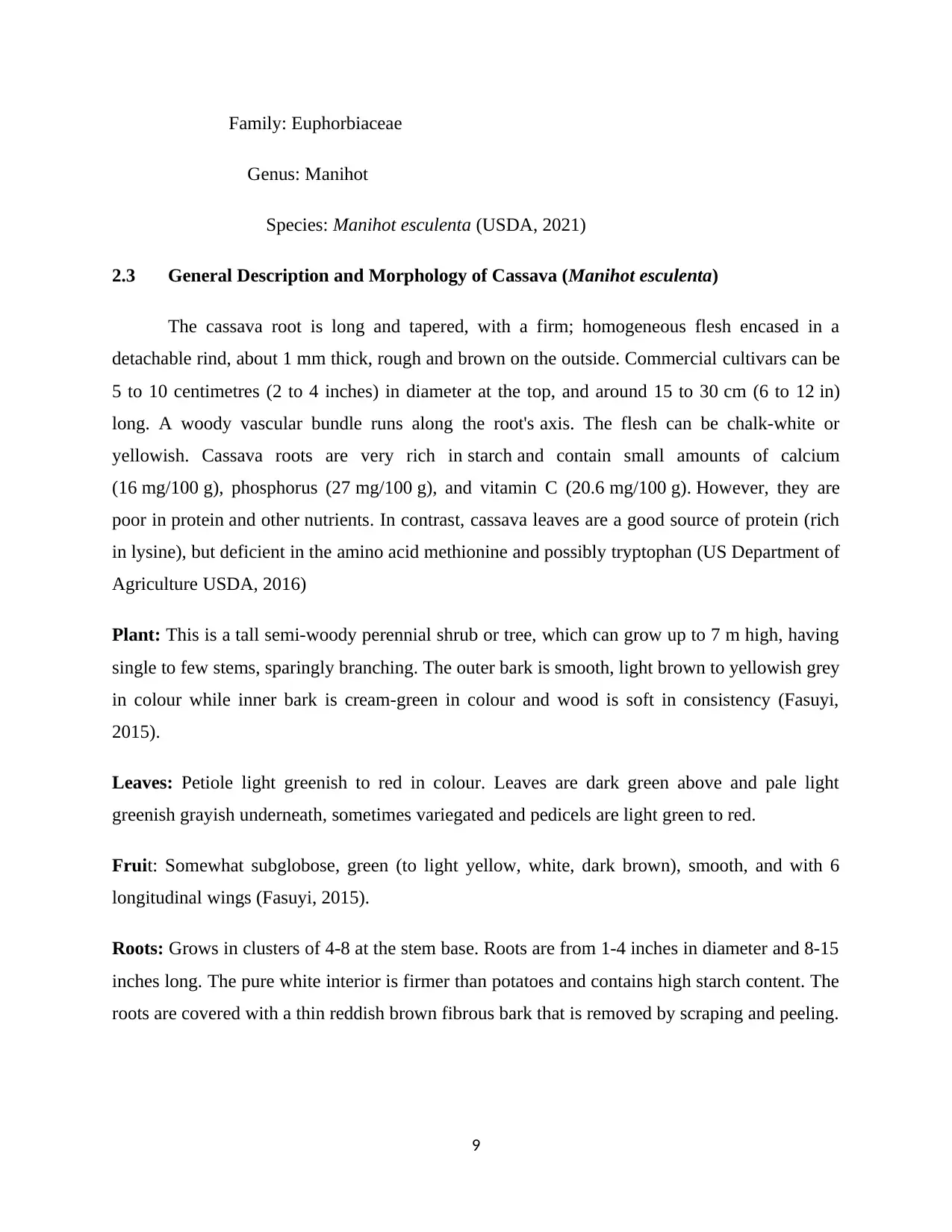
Family: Euphorbiaceae
Genus: Manihot
Species: Manihot esculenta (USDA, 2021)
2.3 General Description and Morphology of Cassava (Manihot esculenta)
The cassava root is long and tapered, with a firm; homogeneous flesh encased in a
detachable rind, about 1 mm thick, rough and brown on the outside. Commercial cultivars can be
5 to 10 centimetres (2 to 4 inches) in diameter at the top, and around 15 to 30 cm (6 to 12 in)
long. A woody vascular bundle runs along the root's axis. The flesh can be chalk-white or
yellowish. Cassava roots are very rich in starch and contain small amounts of calcium
(16 mg/100 g), phosphorus (27 mg/100 g), and vitamin C (20.6 mg/100 g). However, they are
poor in protein and other nutrients. In contrast, cassava leaves are a good source of protein (rich
in lysine), but deficient in the amino acid methionine and possibly tryptophan (US Department of
Agriculture USDA, 2016)
Plant: This is a tall semi-woody perennial shrub or tree, which can grow up to 7 m high, having
single to few stems, sparingly branching. The outer bark is smooth, light brown to yellowish grey
in colour while inner bark is cream-green in colour and wood is soft in consistency (Fasuyi,
2015).
Leaves: Petiole light greenish to red in colour. Leaves are dark green above and pale light
greenish grayish underneath, sometimes variegated and pedicels are light green to red.
Fruit: Somewhat subglobose, green (to light yellow, white, dark brown), smooth, and with 6
longitudinal wings (Fasuyi, 2015).
Roots: Grows in clusters of 4-8 at the stem base. Roots are from 1-4 inches in diameter and 8-15
inches long. The pure white interior is firmer than potatoes and contains high starch content. The
roots are covered with a thin reddish brown fibrous bark that is removed by scraping and peeling.
9
Genus: Manihot
Species: Manihot esculenta (USDA, 2021)
2.3 General Description and Morphology of Cassava (Manihot esculenta)
The cassava root is long and tapered, with a firm; homogeneous flesh encased in a
detachable rind, about 1 mm thick, rough and brown on the outside. Commercial cultivars can be
5 to 10 centimetres (2 to 4 inches) in diameter at the top, and around 15 to 30 cm (6 to 12 in)
long. A woody vascular bundle runs along the root's axis. The flesh can be chalk-white or
yellowish. Cassava roots are very rich in starch and contain small amounts of calcium
(16 mg/100 g), phosphorus (27 mg/100 g), and vitamin C (20.6 mg/100 g). However, they are
poor in protein and other nutrients. In contrast, cassava leaves are a good source of protein (rich
in lysine), but deficient in the amino acid methionine and possibly tryptophan (US Department of
Agriculture USDA, 2016)
Plant: This is a tall semi-woody perennial shrub or tree, which can grow up to 7 m high, having
single to few stems, sparingly branching. The outer bark is smooth, light brown to yellowish grey
in colour while inner bark is cream-green in colour and wood is soft in consistency (Fasuyi,
2015).
Leaves: Petiole light greenish to red in colour. Leaves are dark green above and pale light
greenish grayish underneath, sometimes variegated and pedicels are light green to red.
Fruit: Somewhat subglobose, green (to light yellow, white, dark brown), smooth, and with 6
longitudinal wings (Fasuyi, 2015).
Roots: Grows in clusters of 4-8 at the stem base. Roots are from 1-4 inches in diameter and 8-15
inches long. The pure white interior is firmer than potatoes and contains high starch content. The
roots are covered with a thin reddish brown fibrous bark that is removed by scraping and peeling.
9
You're viewing a preview
Unlock full access by subscribing today!
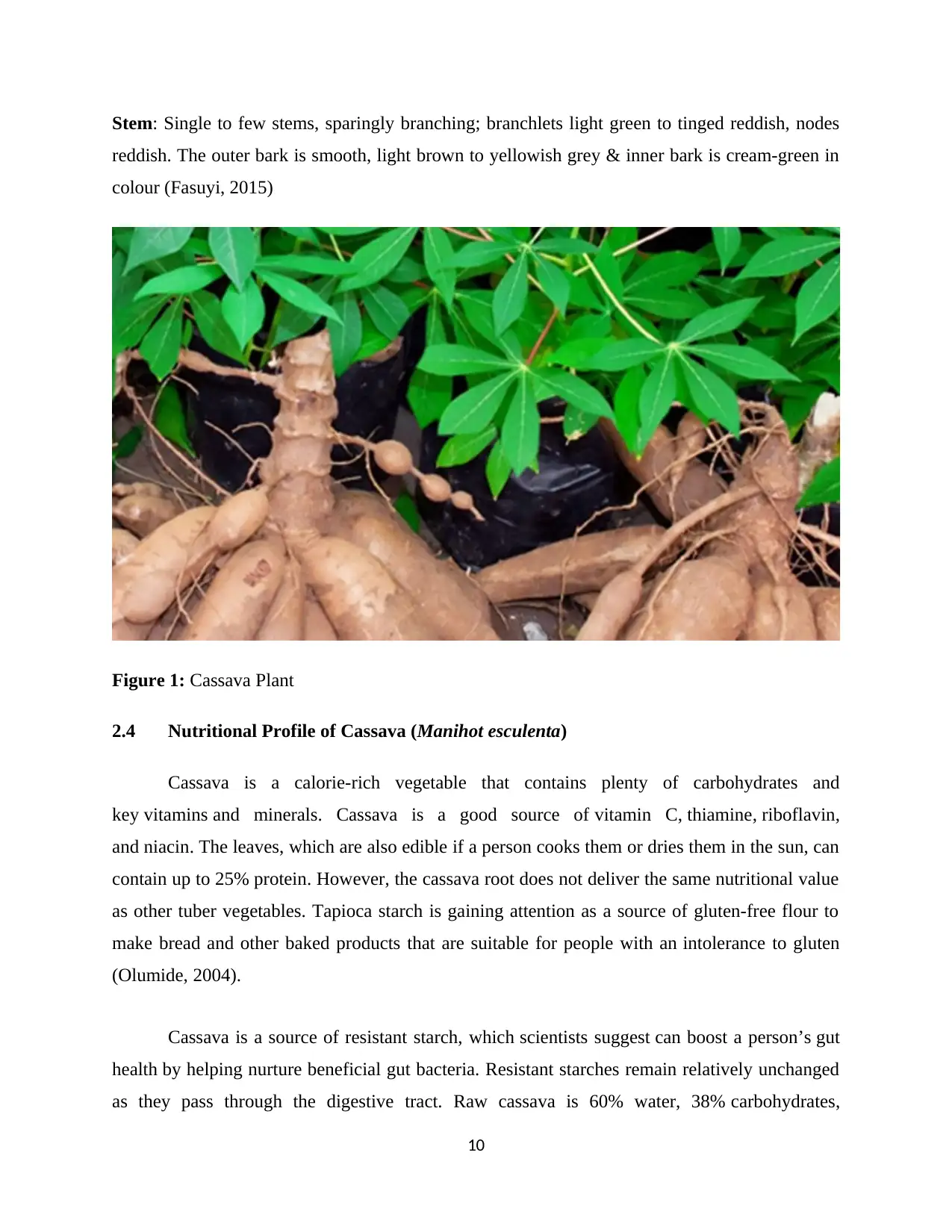
Stem: Single to few stems, sparingly branching; branchlets light green to tinged reddish, nodes
reddish. The outer bark is smooth, light brown to yellowish grey & inner bark is cream-green in
colour (Fasuyi, 2015)
Figure 1: Cassava Plant
2.4 Nutritional Profile of Cassava (Manihot esculenta)
Cassava is a calorie-rich vegetable that contains plenty of carbohydrates and
key vitamins and minerals. Cassava is a good source of vitamin C, thiamine, riboflavin,
and niacin. The leaves, which are also edible if a person cooks them or dries them in the sun, can
contain up to 25% protein. However, the cassava root does not deliver the same nutritional value
as other tuber vegetables. Tapioca starch is gaining attention as a source of gluten-free flour to
make bread and other baked products that are suitable for people with an intolerance to gluten
(Olumide, 2004).
Cassava is a source of resistant starch, which scientists suggest can boost a person’s gut
health by helping nurture beneficial gut bacteria. Resistant starches remain relatively unchanged
as they pass through the digestive tract. Raw cassava is 60% water, 38% carbohydrates,
10
reddish. The outer bark is smooth, light brown to yellowish grey & inner bark is cream-green in
colour (Fasuyi, 2015)
Figure 1: Cassava Plant
2.4 Nutritional Profile of Cassava (Manihot esculenta)
Cassava is a calorie-rich vegetable that contains plenty of carbohydrates and
key vitamins and minerals. Cassava is a good source of vitamin C, thiamine, riboflavin,
and niacin. The leaves, which are also edible if a person cooks them or dries them in the sun, can
contain up to 25% protein. However, the cassava root does not deliver the same nutritional value
as other tuber vegetables. Tapioca starch is gaining attention as a source of gluten-free flour to
make bread and other baked products that are suitable for people with an intolerance to gluten
(Olumide, 2004).
Cassava is a source of resistant starch, which scientists suggest can boost a person’s gut
health by helping nurture beneficial gut bacteria. Resistant starches remain relatively unchanged
as they pass through the digestive tract. Raw cassava is 60% water, 38% carbohydrates,
10
Paraphrase This Document
Need a fresh take? Get an instant paraphrase of this document with our AI Paraphraser
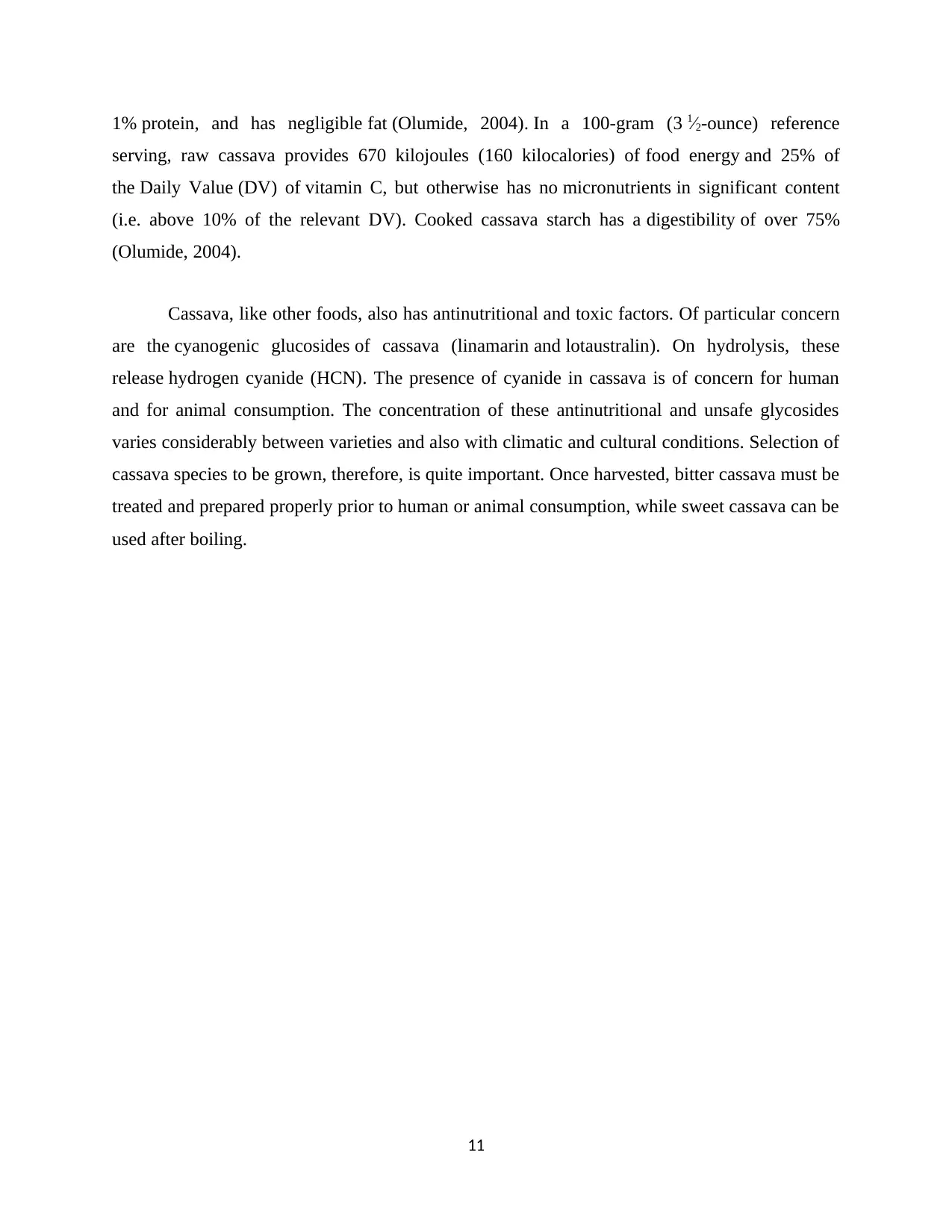
1% protein, and has negligible fat (Olumide, 2004). In a 100-gram (3 1⁄2-ounce) reference
serving, raw cassava provides 670 kilojoules (160 kilocalories) of food energy and 25% of
the Daily Value (DV) of vitamin C, but otherwise has no micronutrients in significant content
(i.e. above 10% of the relevant DV). Cooked cassava starch has a digestibility of over 75%
(Olumide, 2004).
Cassava, like other foods, also has antinutritional and toxic factors. Of particular concern
are the cyanogenic glucosides of cassava (linamarin and lotaustralin). On hydrolysis, these
release hydrogen cyanide (HCN). The presence of cyanide in cassava is of concern for human
and for animal consumption. The concentration of these antinutritional and unsafe glycosides
varies considerably between varieties and also with climatic and cultural conditions. Selection of
cassava species to be grown, therefore, is quite important. Once harvested, bitter cassava must be
treated and prepared properly prior to human or animal consumption, while sweet cassava can be
used after boiling.
11
serving, raw cassava provides 670 kilojoules (160 kilocalories) of food energy and 25% of
the Daily Value (DV) of vitamin C, but otherwise has no micronutrients in significant content
(i.e. above 10% of the relevant DV). Cooked cassava starch has a digestibility of over 75%
(Olumide, 2004).
Cassava, like other foods, also has antinutritional and toxic factors. Of particular concern
are the cyanogenic glucosides of cassava (linamarin and lotaustralin). On hydrolysis, these
release hydrogen cyanide (HCN). The presence of cyanide in cassava is of concern for human
and for animal consumption. The concentration of these antinutritional and unsafe glycosides
varies considerably between varieties and also with climatic and cultural conditions. Selection of
cassava species to be grown, therefore, is quite important. Once harvested, bitter cassava must be
treated and prepared properly prior to human or animal consumption, while sweet cassava can be
used after boiling.
11
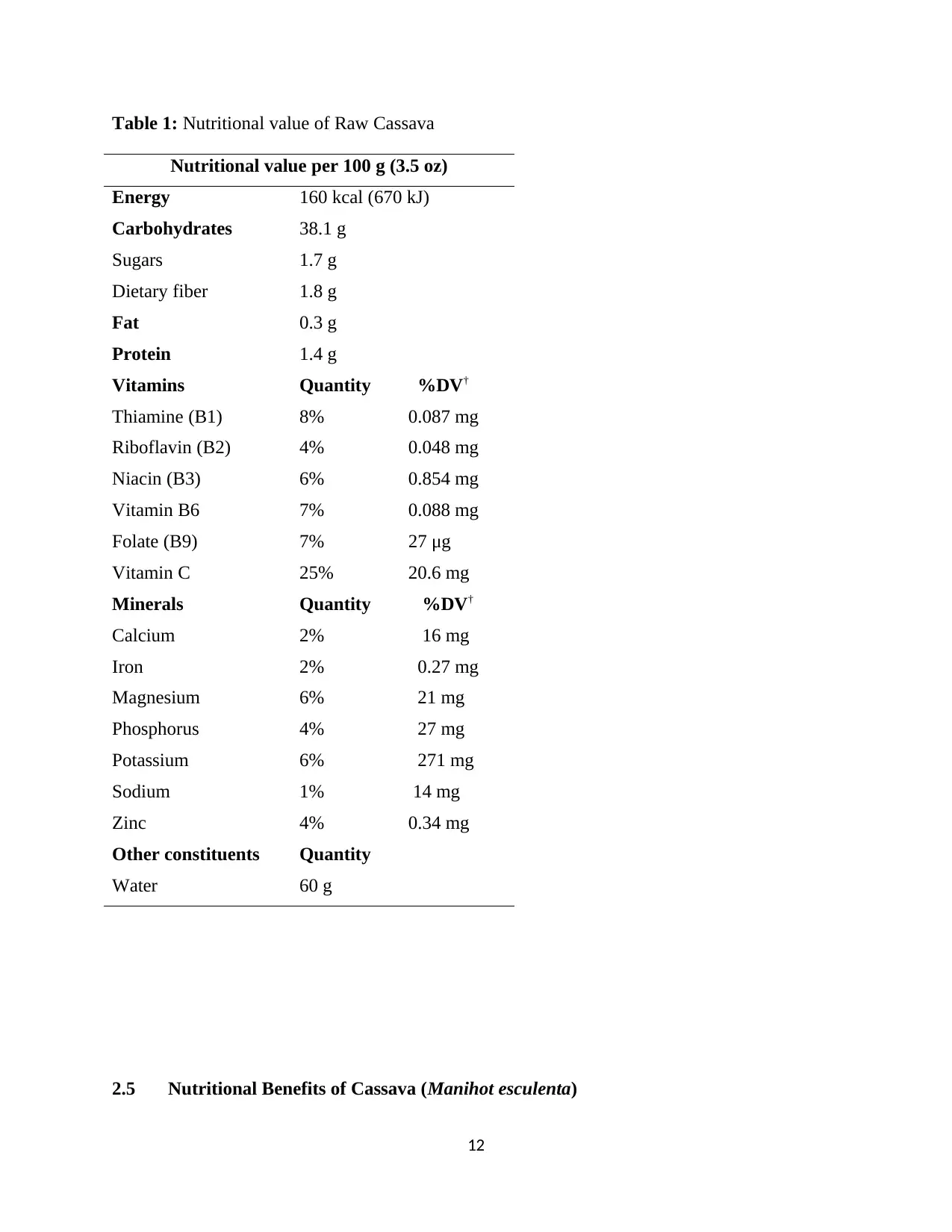
Table 1: Nutritional value of Raw Cassava
Nutritional value per 100 g (3.5 oz)
Energy 160 kcal (670 kJ)
Carbohydrates 38.1 g
Sugars 1.7 g
Dietary fiber 1.8 g
Fat 0.3 g
Protein 1.4 g
Vitamins Quantity %DV†
Thiamine (B1) 8% 0.087 mg
Riboflavin (B2) 4% 0.048 mg
Niacin (B3) 6% 0.854 mg
Vitamin B6 7% 0.088 mg
Folate (B9) 7% 27 μg
Vitamin C 25% 20.6 mg
Minerals Quantity %DV†
Calcium 2% 16 mg
Iron 2% 0.27 mg
Magnesium 6% 21 mg
Phosphorus 4% 27 mg
Potassium 6% 271 mg
Sodium 1% 14 mg
Zinc 4% 0.34 mg
Other constituents Quantity
Water 60 g
2.5 Nutritional Benefits of Cassava (Manihot esculenta)
12
Nutritional value per 100 g (3.5 oz)
Energy 160 kcal (670 kJ)
Carbohydrates 38.1 g
Sugars 1.7 g
Dietary fiber 1.8 g
Fat 0.3 g
Protein 1.4 g
Vitamins Quantity %DV†
Thiamine (B1) 8% 0.087 mg
Riboflavin (B2) 4% 0.048 mg
Niacin (B3) 6% 0.854 mg
Vitamin B6 7% 0.088 mg
Folate (B9) 7% 27 μg
Vitamin C 25% 20.6 mg
Minerals Quantity %DV†
Calcium 2% 16 mg
Iron 2% 0.27 mg
Magnesium 6% 21 mg
Phosphorus 4% 27 mg
Potassium 6% 271 mg
Sodium 1% 14 mg
Zinc 4% 0.34 mg
Other constituents Quantity
Water 60 g
2.5 Nutritional Benefits of Cassava (Manihot esculenta)
12
You're viewing a preview
Unlock full access by subscribing today!
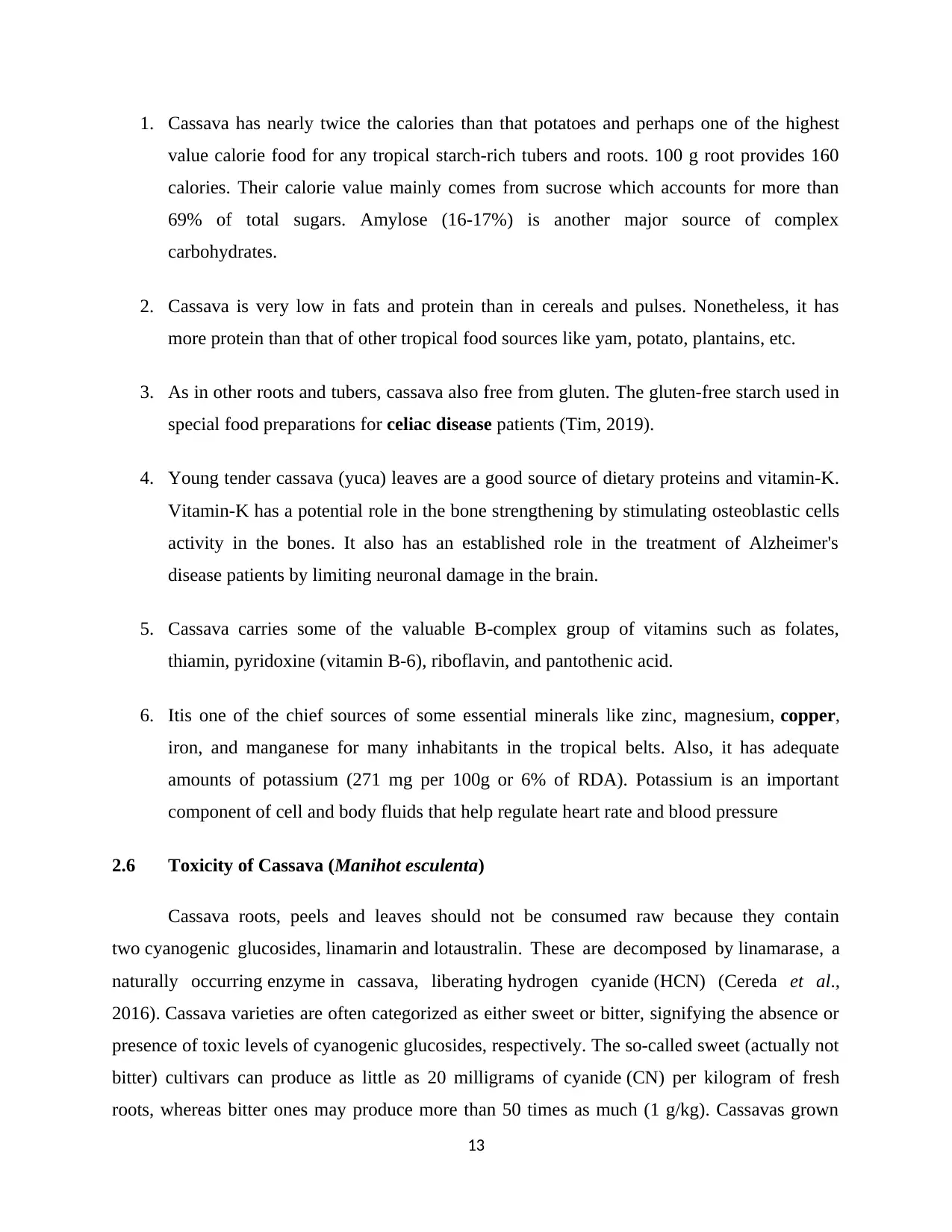
1. Cassava has nearly twice the calories than that potatoes and perhaps one of the highest
value calorie food for any tropical starch-rich tubers and roots. 100 g root provides 160
calories. Their calorie value mainly comes from sucrose which accounts for more than
69% of total sugars. Amylose (16-17%) is another major source of complex
carbohydrates.
2. Cassava is very low in fats and protein than in cereals and pulses. Nonetheless, it has
more protein than that of other tropical food sources like yam, potato, plantains, etc.
3. As in other roots and tubers, cassava also free from gluten. The gluten-free starch used in
special food preparations for celiac disease patients (Tim, 2019).
4. Young tender cassava (yuca) leaves are a good source of dietary proteins and vitamin-K.
Vitamin-K has a potential role in the bone strengthening by stimulating osteoblastic cells
activity in the bones. It also has an established role in the treatment of Alzheimer's
disease patients by limiting neuronal damage in the brain.
5. Cassava carries some of the valuable B-complex group of vitamins such as folates,
thiamin, pyridoxine (vitamin B-6), riboflavin, and pantothenic acid.
6. Itis one of the chief sources of some essential minerals like zinc, magnesium, copper,
iron, and manganese for many inhabitants in the tropical belts. Also, it has adequate
amounts of potassium (271 mg per 100g or 6% of RDA). Potassium is an important
component of cell and body fluids that help regulate heart rate and blood pressure
2.6 Toxicity of Cassava (Manihot esculenta)
Cassava roots, peels and leaves should not be consumed raw because they contain
two cyanogenic glucosides, linamarin and lotaustralin. These are decomposed by linamarase, a
naturally occurring enzyme in cassava, liberating hydrogen cyanide (HCN) (Cereda et al.,
2016). Cassava varieties are often categorized as either sweet or bitter, signifying the absence or
presence of toxic levels of cyanogenic glucosides, respectively. The so-called sweet (actually not
bitter) cultivars can produce as little as 20 milligrams of cyanide (CN) per kilogram of fresh
roots, whereas bitter ones may produce more than 50 times as much (1 g/kg). Cassavas grown
13
value calorie food for any tropical starch-rich tubers and roots. 100 g root provides 160
calories. Their calorie value mainly comes from sucrose which accounts for more than
69% of total sugars. Amylose (16-17%) is another major source of complex
carbohydrates.
2. Cassava is very low in fats and protein than in cereals and pulses. Nonetheless, it has
more protein than that of other tropical food sources like yam, potato, plantains, etc.
3. As in other roots and tubers, cassava also free from gluten. The gluten-free starch used in
special food preparations for celiac disease patients (Tim, 2019).
4. Young tender cassava (yuca) leaves are a good source of dietary proteins and vitamin-K.
Vitamin-K has a potential role in the bone strengthening by stimulating osteoblastic cells
activity in the bones. It also has an established role in the treatment of Alzheimer's
disease patients by limiting neuronal damage in the brain.
5. Cassava carries some of the valuable B-complex group of vitamins such as folates,
thiamin, pyridoxine (vitamin B-6), riboflavin, and pantothenic acid.
6. Itis one of the chief sources of some essential minerals like zinc, magnesium, copper,
iron, and manganese for many inhabitants in the tropical belts. Also, it has adequate
amounts of potassium (271 mg per 100g or 6% of RDA). Potassium is an important
component of cell and body fluids that help regulate heart rate and blood pressure
2.6 Toxicity of Cassava (Manihot esculenta)
Cassava roots, peels and leaves should not be consumed raw because they contain
two cyanogenic glucosides, linamarin and lotaustralin. These are decomposed by linamarase, a
naturally occurring enzyme in cassava, liberating hydrogen cyanide (HCN) (Cereda et al.,
2016). Cassava varieties are often categorized as either sweet or bitter, signifying the absence or
presence of toxic levels of cyanogenic glucosides, respectively. The so-called sweet (actually not
bitter) cultivars can produce as little as 20 milligrams of cyanide (CN) per kilogram of fresh
roots, whereas bitter ones may produce more than 50 times as much (1 g/kg). Cassavas grown
13
Paraphrase This Document
Need a fresh take? Get an instant paraphrase of this document with our AI Paraphraser
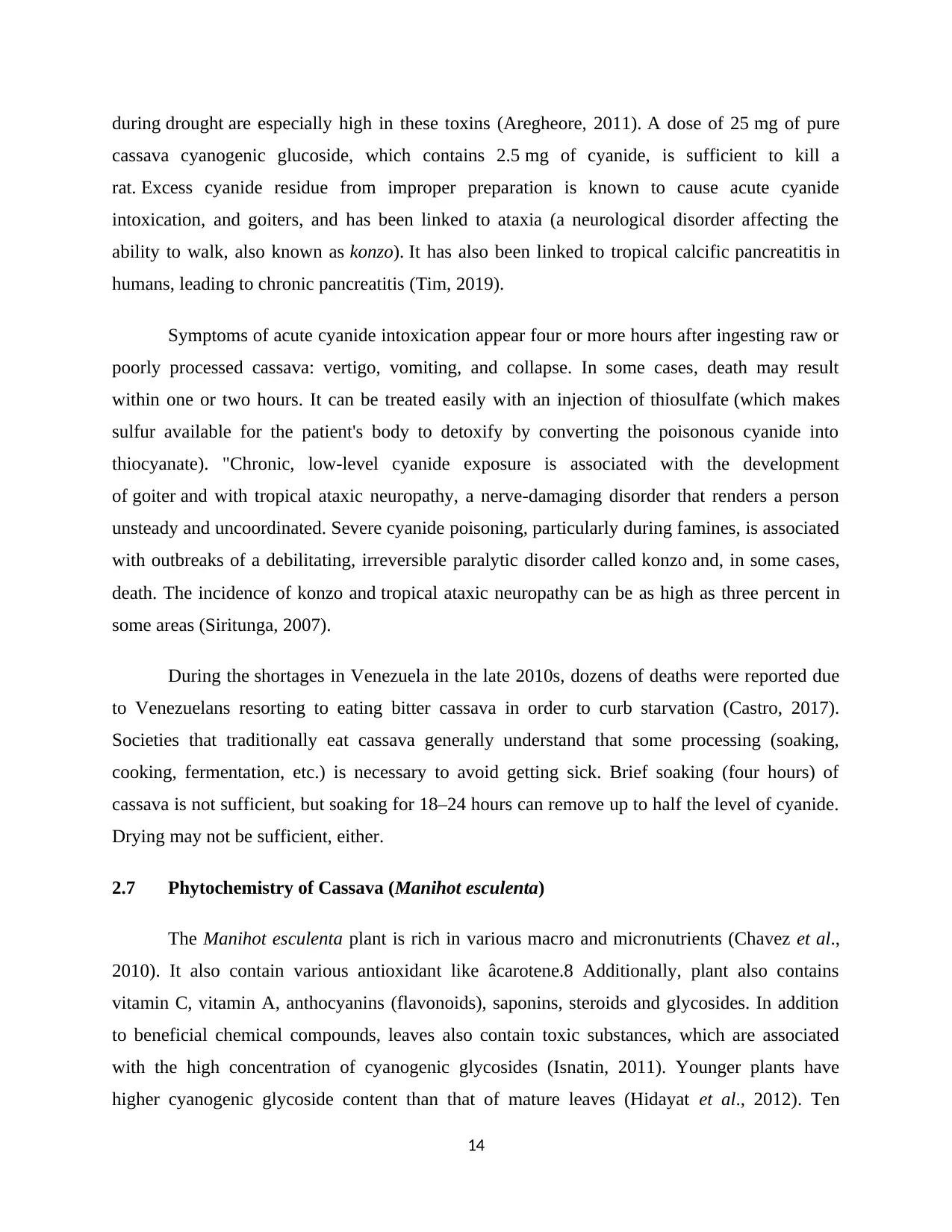
during drought are especially high in these toxins (Aregheore, 2011). A dose of 25 mg of pure
cassava cyanogenic glucoside, which contains 2.5 mg of cyanide, is sufficient to kill a
rat. Excess cyanide residue from improper preparation is known to cause acute cyanide
intoxication, and goiters, and has been linked to ataxia (a neurological disorder affecting the
ability to walk, also known as konzo). It has also been linked to tropical calcific pancreatitis in
humans, leading to chronic pancreatitis (Tim, 2019).
Symptoms of acute cyanide intoxication appear four or more hours after ingesting raw or
poorly processed cassava: vertigo, vomiting, and collapse. In some cases, death may result
within one or two hours. It can be treated easily with an injection of thiosulfate (which makes
sulfur available for the patient's body to detoxify by converting the poisonous cyanide into
thiocyanate). "Chronic, low-level cyanide exposure is associated with the development
of goiter and with tropical ataxic neuropathy, a nerve-damaging disorder that renders a person
unsteady and uncoordinated. Severe cyanide poisoning, particularly during famines, is associated
with outbreaks of a debilitating, irreversible paralytic disorder called konzo and, in some cases,
death. The incidence of konzo and tropical ataxic neuropathy can be as high as three percent in
some areas (Siritunga, 2007).
During the shortages in Venezuela in the late 2010s, dozens of deaths were reported due
to Venezuelans resorting to eating bitter cassava in order to curb starvation (Castro, 2017).
Societies that traditionally eat cassava generally understand that some processing (soaking,
cooking, fermentation, etc.) is necessary to avoid getting sick. Brief soaking (four hours) of
cassava is not sufficient, but soaking for 18–24 hours can remove up to half the level of cyanide.
Drying may not be sufficient, either.
2.7 Phytochemistry of Cassava (Manihot esculenta)
The Manihot esculenta plant is rich in various macro and micronutrients (Chavez et al.,
2010). It also contain various antioxidant like âcarotene.8 Additionally, plant also contains
vitamin C, vitamin A, anthocyanins (flavonoids), saponins, steroids and glycosides. In addition
to beneficial chemical compounds, leaves also contain toxic substances, which are associated
with the high concentration of cyanogenic glycosides (Isnatin, 2011). Younger plants have
higher cyanogenic glycoside content than that of mature leaves (Hidayat et al., 2012). Ten
14
cassava cyanogenic glucoside, which contains 2.5 mg of cyanide, is sufficient to kill a
rat. Excess cyanide residue from improper preparation is known to cause acute cyanide
intoxication, and goiters, and has been linked to ataxia (a neurological disorder affecting the
ability to walk, also known as konzo). It has also been linked to tropical calcific pancreatitis in
humans, leading to chronic pancreatitis (Tim, 2019).
Symptoms of acute cyanide intoxication appear four or more hours after ingesting raw or
poorly processed cassava: vertigo, vomiting, and collapse. In some cases, death may result
within one or two hours. It can be treated easily with an injection of thiosulfate (which makes
sulfur available for the patient's body to detoxify by converting the poisonous cyanide into
thiocyanate). "Chronic, low-level cyanide exposure is associated with the development
of goiter and with tropical ataxic neuropathy, a nerve-damaging disorder that renders a person
unsteady and uncoordinated. Severe cyanide poisoning, particularly during famines, is associated
with outbreaks of a debilitating, irreversible paralytic disorder called konzo and, in some cases,
death. The incidence of konzo and tropical ataxic neuropathy can be as high as three percent in
some areas (Siritunga, 2007).
During the shortages in Venezuela in the late 2010s, dozens of deaths were reported due
to Venezuelans resorting to eating bitter cassava in order to curb starvation (Castro, 2017).
Societies that traditionally eat cassava generally understand that some processing (soaking,
cooking, fermentation, etc.) is necessary to avoid getting sick. Brief soaking (four hours) of
cassava is not sufficient, but soaking for 18–24 hours can remove up to half the level of cyanide.
Drying may not be sufficient, either.
2.7 Phytochemistry of Cassava (Manihot esculenta)
The Manihot esculenta plant is rich in various macro and micronutrients (Chavez et al.,
2010). It also contain various antioxidant like âcarotene.8 Additionally, plant also contains
vitamin C, vitamin A, anthocyanins (flavonoids), saponins, steroids and glycosides. In addition
to beneficial chemical compounds, leaves also contain toxic substances, which are associated
with the high concentration of cyanogenic glycosides (Isnatin, 2011). Younger plants have
higher cyanogenic glycoside content than that of mature leaves (Hidayat et al., 2012). Ten
14
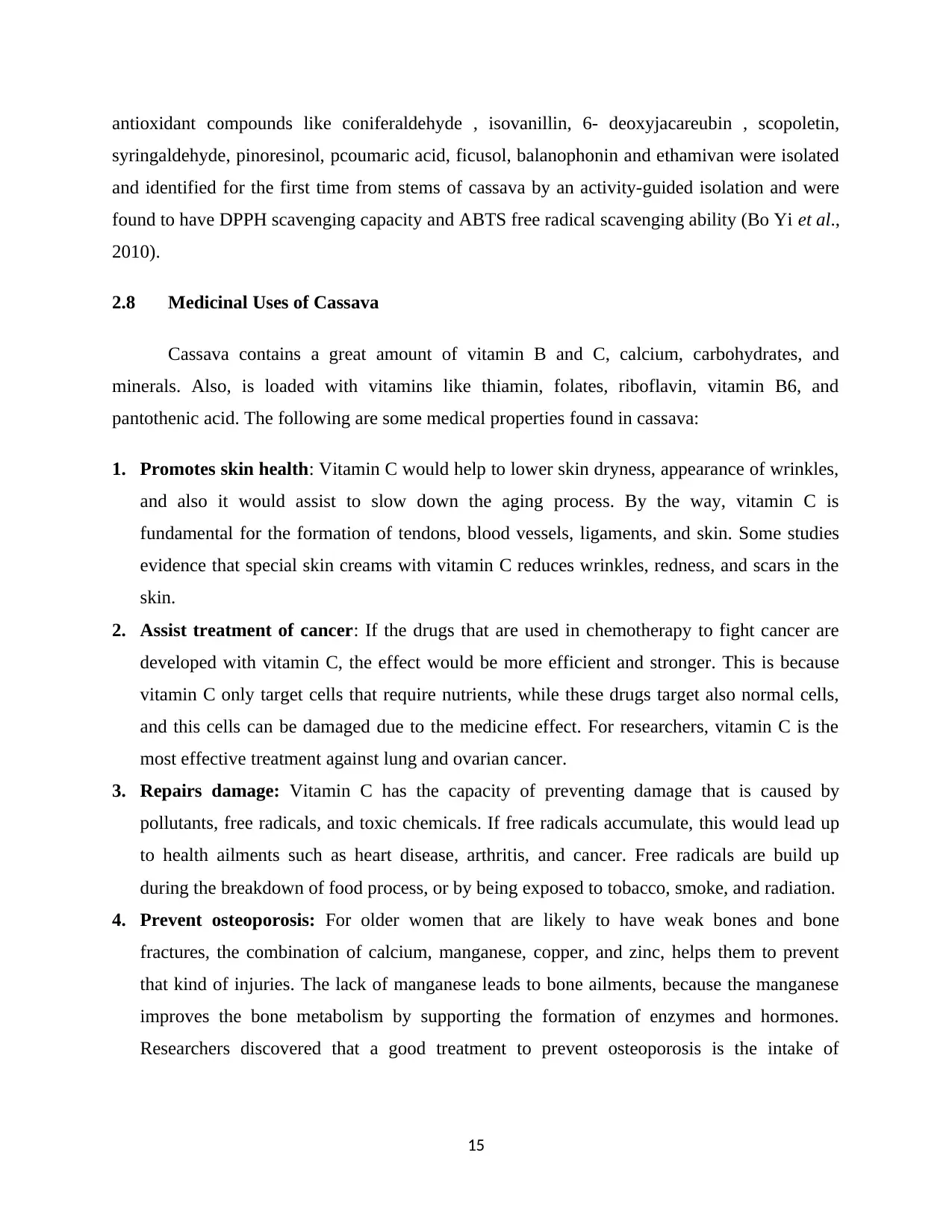
antioxidant compounds like coniferaldehyde , isovanillin, 6- deoxyjacareubin , scopoletin,
syringaldehyde, pinoresinol, pcoumaric acid, ficusol, balanophonin and ethamivan were isolated
and identified for the first time from stems of cassava by an activity-guided isolation and were
found to have DPPH scavenging capacity and ABTS free radical scavenging ability (Bo Yi et al.,
2010).
2.8 Medicinal Uses of Cassava
Cassava contains a great amount of vitamin B and C, calcium, carbohydrates, and
minerals. Also, is loaded with vitamins like thiamin, folates, riboflavin, vitamin B6, and
pantothenic acid. The following are some medical properties found in cassava:
1. Promotes skin health: Vitamin C would help to lower skin dryness, appearance of wrinkles,
and also it would assist to slow down the aging process. By the way, vitamin C is
fundamental for the formation of tendons, blood vessels, ligaments, and skin. Some studies
evidence that special skin creams with vitamin C reduces wrinkles, redness, and scars in the
skin.
2. Assist treatment of cancer: If the drugs that are used in chemotherapy to fight cancer are
developed with vitamin C, the effect would be more efficient and stronger. This is because
vitamin C only target cells that require nutrients, while these drugs target also normal cells,
and this cells can be damaged due to the medicine effect. For researchers, vitamin C is the
most effective treatment against lung and ovarian cancer.
3. Repairs damage: Vitamin C has the capacity of preventing damage that is caused by
pollutants, free radicals, and toxic chemicals. If free radicals accumulate, this would lead up
to health ailments such as heart disease, arthritis, and cancer. Free radicals are build up
during the breakdown of food process, or by being exposed to tobacco, smoke, and radiation.
4. Prevent osteoporosis: For older women that are likely to have weak bones and bone
fractures, the combination of calcium, manganese, copper, and zinc, helps them to prevent
that kind of injuries. The lack of manganese leads to bone ailments, because the manganese
improves the bone metabolism by supporting the formation of enzymes and hormones.
Researchers discovered that a good treatment to prevent osteoporosis is the intake of
15
syringaldehyde, pinoresinol, pcoumaric acid, ficusol, balanophonin and ethamivan were isolated
and identified for the first time from stems of cassava by an activity-guided isolation and were
found to have DPPH scavenging capacity and ABTS free radical scavenging ability (Bo Yi et al.,
2010).
2.8 Medicinal Uses of Cassava
Cassava contains a great amount of vitamin B and C, calcium, carbohydrates, and
minerals. Also, is loaded with vitamins like thiamin, folates, riboflavin, vitamin B6, and
pantothenic acid. The following are some medical properties found in cassava:
1. Promotes skin health: Vitamin C would help to lower skin dryness, appearance of wrinkles,
and also it would assist to slow down the aging process. By the way, vitamin C is
fundamental for the formation of tendons, blood vessels, ligaments, and skin. Some studies
evidence that special skin creams with vitamin C reduces wrinkles, redness, and scars in the
skin.
2. Assist treatment of cancer: If the drugs that are used in chemotherapy to fight cancer are
developed with vitamin C, the effect would be more efficient and stronger. This is because
vitamin C only target cells that require nutrients, while these drugs target also normal cells,
and this cells can be damaged due to the medicine effect. For researchers, vitamin C is the
most effective treatment against lung and ovarian cancer.
3. Repairs damage: Vitamin C has the capacity of preventing damage that is caused by
pollutants, free radicals, and toxic chemicals. If free radicals accumulate, this would lead up
to health ailments such as heart disease, arthritis, and cancer. Free radicals are build up
during the breakdown of food process, or by being exposed to tobacco, smoke, and radiation.
4. Prevent osteoporosis: For older women that are likely to have weak bones and bone
fractures, the combination of calcium, manganese, copper, and zinc, helps them to prevent
that kind of injuries. The lack of manganese leads to bone ailments, because the manganese
improves the bone metabolism by supporting the formation of enzymes and hormones.
Researchers discovered that a good treatment to prevent osteoporosis is the intake of
15
You're viewing a preview
Unlock full access by subscribing today!
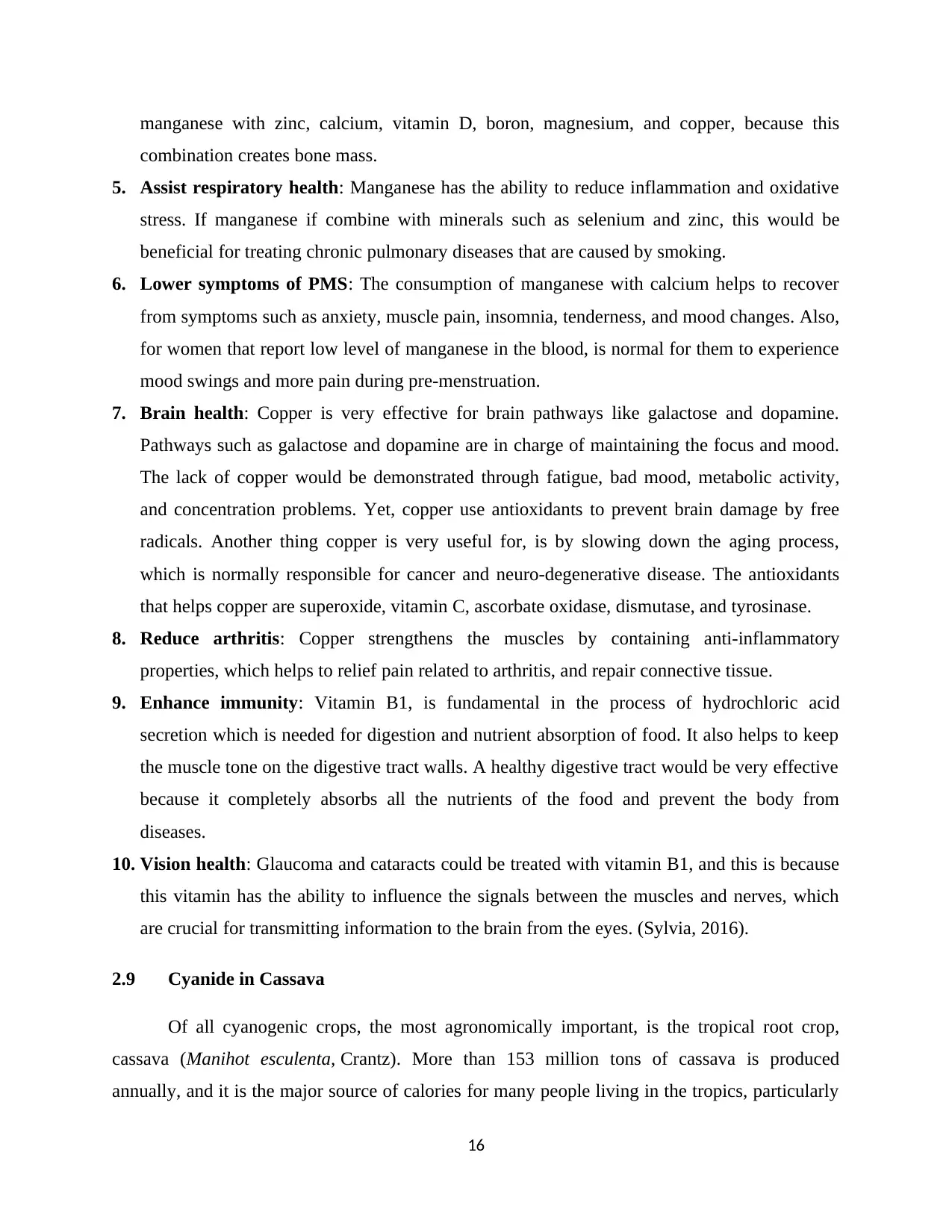
manganese with zinc, calcium, vitamin D, boron, magnesium, and copper, because this
combination creates bone mass.
5. Assist respiratory health: Manganese has the ability to reduce inflammation and oxidative
stress. If manganese if combine with minerals such as selenium and zinc, this would be
beneficial for treating chronic pulmonary diseases that are caused by smoking.
6. Lower symptoms of PMS: The consumption of manganese with calcium helps to recover
from symptoms such as anxiety, muscle pain, insomnia, tenderness, and mood changes. Also,
for women that report low level of manganese in the blood, is normal for them to experience
mood swings and more pain during pre-menstruation.
7. Brain health: Copper is very effective for brain pathways like galactose and dopamine.
Pathways such as galactose and dopamine are in charge of maintaining the focus and mood.
The lack of copper would be demonstrated through fatigue, bad mood, metabolic activity,
and concentration problems. Yet, copper use antioxidants to prevent brain damage by free
radicals. Another thing copper is very useful for, is by slowing down the aging process,
which is normally responsible for cancer and neuro-degenerative disease. The antioxidants
that helps copper are superoxide, vitamin C, ascorbate oxidase, dismutase, and tyrosinase.
8. Reduce arthritis: Copper strengthens the muscles by containing anti-inflammatory
properties, which helps to relief pain related to arthritis, and repair connective tissue.
9. Enhance immunity: Vitamin B1, is fundamental in the process of hydrochloric acid
secretion which is needed for digestion and nutrient absorption of food. It also helps to keep
the muscle tone on the digestive tract walls. A healthy digestive tract would be very effective
because it completely absorbs all the nutrients of the food and prevent the body from
diseases.
10. Vision health: Glaucoma and cataracts could be treated with vitamin B1, and this is because
this vitamin has the ability to influence the signals between the muscles and nerves, which
are crucial for transmitting information to the brain from the eyes. (Sylvia, 2016).
2.9 Cyanide in Cassava
Of all cyanogenic crops, the most agronomically important, is the tropical root crop,
cassava (Manihot esculenta, Crantz). More than 153 million tons of cassava is produced
annually, and it is the major source of calories for many people living in the tropics, particularly
16
combination creates bone mass.
5. Assist respiratory health: Manganese has the ability to reduce inflammation and oxidative
stress. If manganese if combine with minerals such as selenium and zinc, this would be
beneficial for treating chronic pulmonary diseases that are caused by smoking.
6. Lower symptoms of PMS: The consumption of manganese with calcium helps to recover
from symptoms such as anxiety, muscle pain, insomnia, tenderness, and mood changes. Also,
for women that report low level of manganese in the blood, is normal for them to experience
mood swings and more pain during pre-menstruation.
7. Brain health: Copper is very effective for brain pathways like galactose and dopamine.
Pathways such as galactose and dopamine are in charge of maintaining the focus and mood.
The lack of copper would be demonstrated through fatigue, bad mood, metabolic activity,
and concentration problems. Yet, copper use antioxidants to prevent brain damage by free
radicals. Another thing copper is very useful for, is by slowing down the aging process,
which is normally responsible for cancer and neuro-degenerative disease. The antioxidants
that helps copper are superoxide, vitamin C, ascorbate oxidase, dismutase, and tyrosinase.
8. Reduce arthritis: Copper strengthens the muscles by containing anti-inflammatory
properties, which helps to relief pain related to arthritis, and repair connective tissue.
9. Enhance immunity: Vitamin B1, is fundamental in the process of hydrochloric acid
secretion which is needed for digestion and nutrient absorption of food. It also helps to keep
the muscle tone on the digestive tract walls. A healthy digestive tract would be very effective
because it completely absorbs all the nutrients of the food and prevent the body from
diseases.
10. Vision health: Glaucoma and cataracts could be treated with vitamin B1, and this is because
this vitamin has the ability to influence the signals between the muscles and nerves, which
are crucial for transmitting information to the brain from the eyes. (Sylvia, 2016).
2.9 Cyanide in Cassava
Of all cyanogenic crops, the most agronomically important, is the tropical root crop,
cassava (Manihot esculenta, Crantz). More than 153 million tons of cassava is produced
annually, and it is the major source of calories for many people living in the tropics, particularly
16
Paraphrase This Document
Need a fresh take? Get an instant paraphrase of this document with our AI Paraphraser
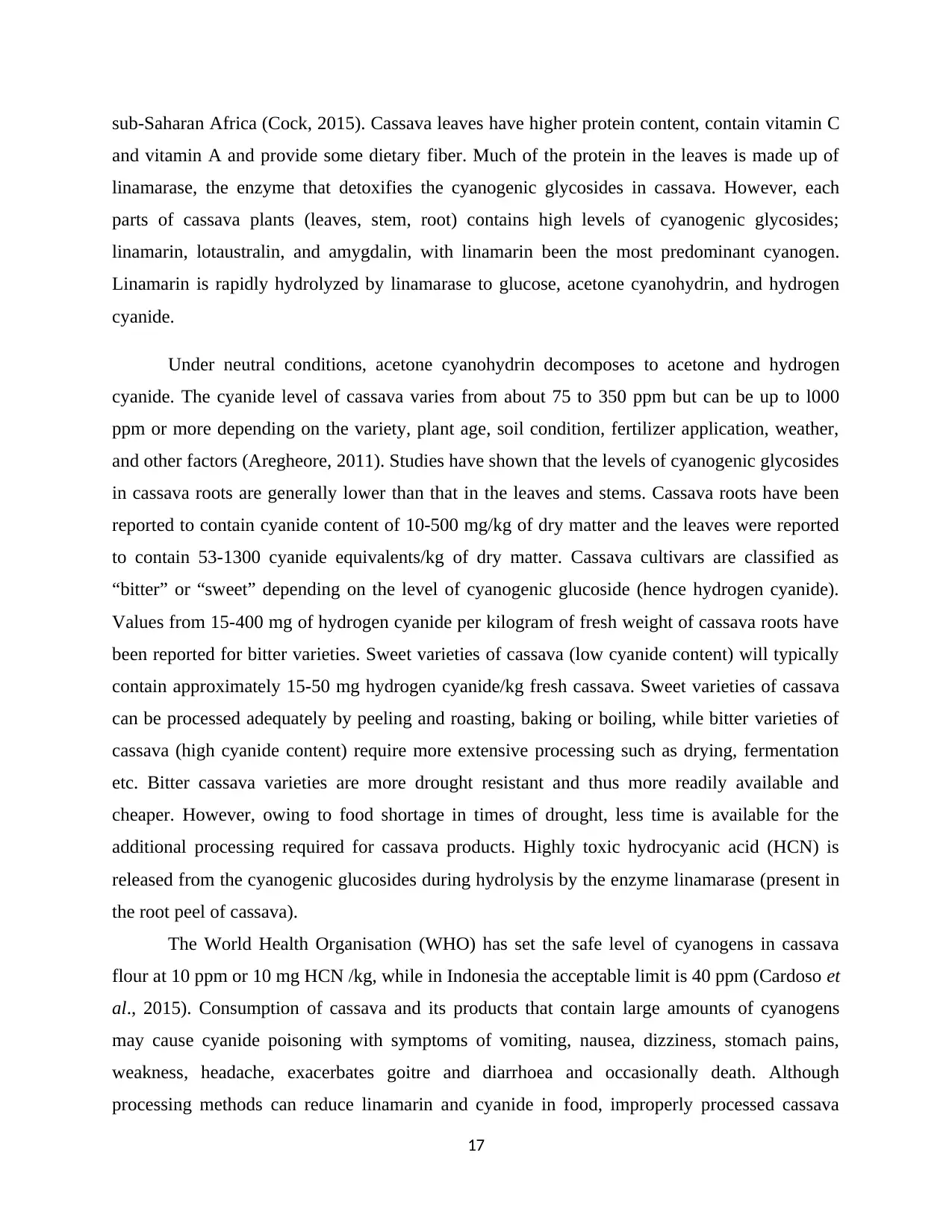
sub-Saharan Africa (Cock, 2015). Cassava leaves have higher protein content, contain vitamin C
and vitamin A and provide some dietary fiber. Much of the protein in the leaves is made up of
linamarase, the enzyme that detoxifies the cyanogenic glycosides in cassava. However, each
parts of cassava plants (leaves, stem, root) contains high levels of cyanogenic glycosides;
linamarin, lotaustralin, and amygdalin, with linamarin been the most predominant cyanogen.
Linamarin is rapidly hydrolyzed by linamarase to glucose, acetone cyanohydrin, and hydrogen
cyanide.
Under neutral conditions, acetone cyanohydrin decomposes to acetone and hydrogen
cyanide. The cyanide level of cassava varies from about 75 to 350 ppm but can be up to l000
ppm or more depending on the variety, plant age, soil condition, fertilizer application, weather,
and other factors (Aregheore, 2011). Studies have shown that the levels of cyanogenic glycosides
in cassava roots are generally lower than that in the leaves and stems. Cassava roots have been
reported to contain cyanide content of 10-500 mg/kg of dry matter and the leaves were reported
to contain 53-1300 cyanide equivalents/kg of dry matter. Cassava cultivars are classified as
“bitter” or “sweet” depending on the level of cyanogenic glucoside (hence hydrogen cyanide).
Values from 15-400 mg of hydrogen cyanide per kilogram of fresh weight of cassava roots have
been reported for bitter varieties. Sweet varieties of cassava (low cyanide content) will typically
contain approximately 15-50 mg hydrogen cyanide/kg fresh cassava. Sweet varieties of cassava
can be processed adequately by peeling and roasting, baking or boiling, while bitter varieties of
cassava (high cyanide content) require more extensive processing such as drying, fermentation
etc. Bitter cassava varieties are more drought resistant and thus more readily available and
cheaper. However, owing to food shortage in times of drought, less time is available for the
additional processing required for cassava products. Highly toxic hydrocyanic acid (HCN) is
released from the cyanogenic glucosides during hydrolysis by the enzyme linamarase (present in
the root peel of cassava).
The World Health Organisation (WHO) has set the safe level of cyanogens in cassava
flour at 10 ppm or 10 mg HCN /kg, while in Indonesia the acceptable limit is 40 ppm (Cardoso et
al., 2015). Consumption of cassava and its products that contain large amounts of cyanogens
may cause cyanide poisoning with symptoms of vomiting, nausea, dizziness, stomach pains,
weakness, headache, exacerbates goitre and diarrhoea and occasionally death. Although
processing methods can reduce linamarin and cyanide in food, improperly processed cassava
17
and vitamin A and provide some dietary fiber. Much of the protein in the leaves is made up of
linamarase, the enzyme that detoxifies the cyanogenic glycosides in cassava. However, each
parts of cassava plants (leaves, stem, root) contains high levels of cyanogenic glycosides;
linamarin, lotaustralin, and amygdalin, with linamarin been the most predominant cyanogen.
Linamarin is rapidly hydrolyzed by linamarase to glucose, acetone cyanohydrin, and hydrogen
cyanide.
Under neutral conditions, acetone cyanohydrin decomposes to acetone and hydrogen
cyanide. The cyanide level of cassava varies from about 75 to 350 ppm but can be up to l000
ppm or more depending on the variety, plant age, soil condition, fertilizer application, weather,
and other factors (Aregheore, 2011). Studies have shown that the levels of cyanogenic glycosides
in cassava roots are generally lower than that in the leaves and stems. Cassava roots have been
reported to contain cyanide content of 10-500 mg/kg of dry matter and the leaves were reported
to contain 53-1300 cyanide equivalents/kg of dry matter. Cassava cultivars are classified as
“bitter” or “sweet” depending on the level of cyanogenic glucoside (hence hydrogen cyanide).
Values from 15-400 mg of hydrogen cyanide per kilogram of fresh weight of cassava roots have
been reported for bitter varieties. Sweet varieties of cassava (low cyanide content) will typically
contain approximately 15-50 mg hydrogen cyanide/kg fresh cassava. Sweet varieties of cassava
can be processed adequately by peeling and roasting, baking or boiling, while bitter varieties of
cassava (high cyanide content) require more extensive processing such as drying, fermentation
etc. Bitter cassava varieties are more drought resistant and thus more readily available and
cheaper. However, owing to food shortage in times of drought, less time is available for the
additional processing required for cassava products. Highly toxic hydrocyanic acid (HCN) is
released from the cyanogenic glucosides during hydrolysis by the enzyme linamarase (present in
the root peel of cassava).
The World Health Organisation (WHO) has set the safe level of cyanogens in cassava
flour at 10 ppm or 10 mg HCN /kg, while in Indonesia the acceptable limit is 40 ppm (Cardoso et
al., 2015). Consumption of cassava and its products that contain large amounts of cyanogens
may cause cyanide poisoning with symptoms of vomiting, nausea, dizziness, stomach pains,
weakness, headache, exacerbates goitre and diarrhoea and occasionally death. Although
processing methods can reduce linamarin and cyanide in food, improperly processed cassava
17
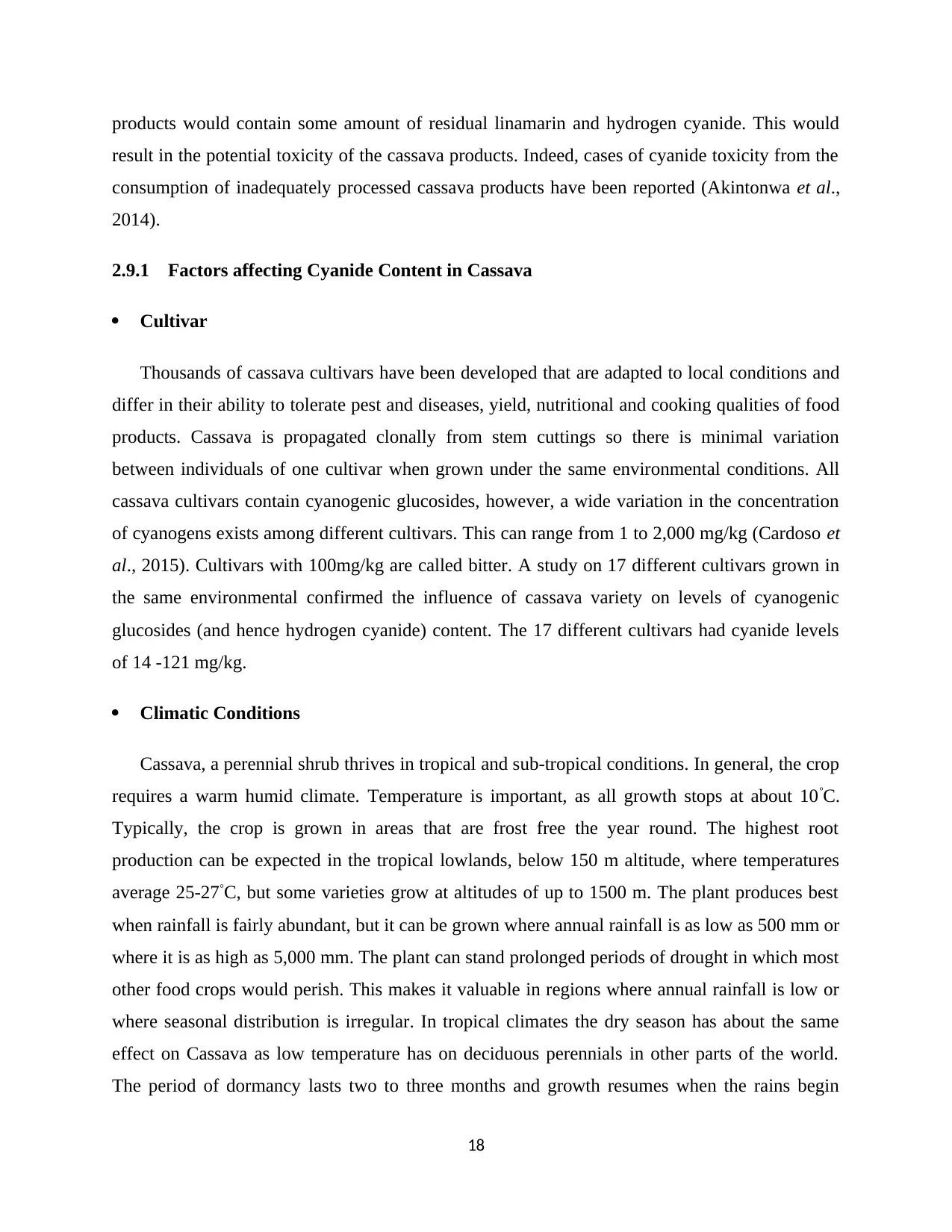
products would contain some amount of residual linamarin and hydrogen cyanide. This would
result in the potential toxicity of the cassava products. Indeed, cases of cyanide toxicity from the
consumption of inadequately processed cassava products have been reported (Akintonwa et al.,
2014).
2.9.1 Factors affecting Cyanide Content in Cassava
Cultivar
Thousands of cassava cultivars have been developed that are adapted to local conditions and
differ in their ability to tolerate pest and diseases, yield, nutritional and cooking qualities of food
products. Cassava is propagated clonally from stem cuttings so there is minimal variation
between individuals of one cultivar when grown under the same environmental conditions. All
cassava cultivars contain cyanogenic glucosides, however, a wide variation in the concentration
of cyanogens exists among different cultivars. This can range from 1 to 2,000 mg/kg (Cardoso et
al., 2015). Cultivars with 100mg/kg are called bitter. A study on 17 different cultivars grown in
the same environmental confirmed the influence of cassava variety on levels of cyanogenic
glucosides (and hence hydrogen cyanide) content. The 17 different cultivars had cyanide levels
of 14 -121 mg/kg.
Climatic Conditions
Cassava, a perennial shrub thrives in tropical and sub-tropical conditions. In general, the crop
requires a warm humid climate. Temperature is important, as all growth stops at about 10ºC.
Typically, the crop is grown in areas that are frost free the year round. The highest root
production can be expected in the tropical lowlands, below 150 m altitude, where temperatures
average 25-27°C, but some varieties grow at altitudes of up to 1500 m. The plant produces best
when rainfall is fairly abundant, but it can be grown where annual rainfall is as low as 500 mm or
where it is as high as 5,000 mm. The plant can stand prolonged periods of drought in which most
other food crops would perish. This makes it valuable in regions where annual rainfall is low or
where seasonal distribution is irregular. In tropical climates the dry season has about the same
effect on Cassava as low temperature has on deciduous perennials in other parts of the world.
The period of dormancy lasts two to three months and growth resumes when the rains begin
18
result in the potential toxicity of the cassava products. Indeed, cases of cyanide toxicity from the
consumption of inadequately processed cassava products have been reported (Akintonwa et al.,
2014).
2.9.1 Factors affecting Cyanide Content in Cassava
Cultivar
Thousands of cassava cultivars have been developed that are adapted to local conditions and
differ in their ability to tolerate pest and diseases, yield, nutritional and cooking qualities of food
products. Cassava is propagated clonally from stem cuttings so there is minimal variation
between individuals of one cultivar when grown under the same environmental conditions. All
cassava cultivars contain cyanogenic glucosides, however, a wide variation in the concentration
of cyanogens exists among different cultivars. This can range from 1 to 2,000 mg/kg (Cardoso et
al., 2015). Cultivars with 100mg/kg are called bitter. A study on 17 different cultivars grown in
the same environmental confirmed the influence of cassava variety on levels of cyanogenic
glucosides (and hence hydrogen cyanide) content. The 17 different cultivars had cyanide levels
of 14 -121 mg/kg.
Climatic Conditions
Cassava, a perennial shrub thrives in tropical and sub-tropical conditions. In general, the crop
requires a warm humid climate. Temperature is important, as all growth stops at about 10ºC.
Typically, the crop is grown in areas that are frost free the year round. The highest root
production can be expected in the tropical lowlands, below 150 m altitude, where temperatures
average 25-27°C, but some varieties grow at altitudes of up to 1500 m. The plant produces best
when rainfall is fairly abundant, but it can be grown where annual rainfall is as low as 500 mm or
where it is as high as 5,000 mm. The plant can stand prolonged periods of drought in which most
other food crops would perish. This makes it valuable in regions where annual rainfall is low or
where seasonal distribution is irregular. In tropical climates the dry season has about the same
effect on Cassava as low temperature has on deciduous perennials in other parts of the world.
The period of dormancy lasts two to three months and growth resumes when the rains begin
18
You're viewing a preview
Unlock full access by subscribing today!
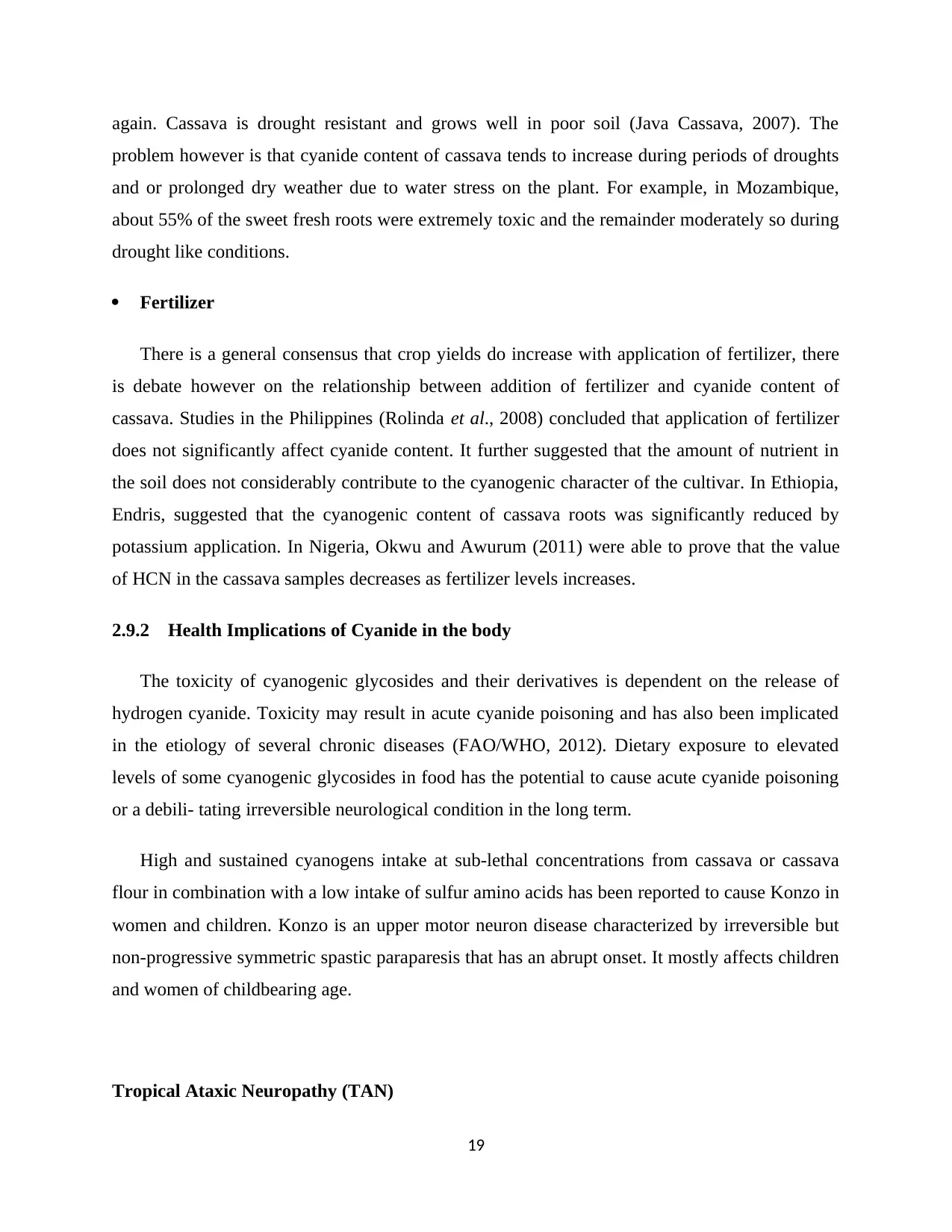
again. Cassava is drought resistant and grows well in poor soil (Java Cassava, 2007). The
problem however is that cyanide content of cassava tends to increase during periods of droughts
and or prolonged dry weather due to water stress on the plant. For example, in Mozambique,
about 55% of the sweet fresh roots were extremely toxic and the remainder moderately so during
drought like conditions.
Fertilizer
There is a general consensus that crop yields do increase with application of fertilizer, there
is debate however on the relationship between addition of fertilizer and cyanide content of
cassava. Studies in the Philippines (Rolinda et al., 2008) concluded that application of fertilizer
does not significantly affect cyanide content. It further suggested that the amount of nutrient in
the soil does not considerably contribute to the cyanogenic character of the cultivar. In Ethiopia,
Endris, suggested that the cyanogenic content of cassava roots was significantly reduced by
potassium application. In Nigeria, Okwu and Awurum (2011) were able to prove that the value
of HCN in the cassava samples decreases as fertilizer levels increases.
2.9.2 Health Implications of Cyanide in the body
The toxicity of cyanogenic glycosides and their derivatives is dependent on the release of
hydrogen cyanide. Toxicity may result in acute cyanide poisoning and has also been implicated
in the etiology of several chronic diseases (FAO/WHO, 2012). Dietary exposure to elevated
levels of some cyanogenic glycosides in food has the potential to cause acute cyanide poisoning
or a debili‐ tating irreversible neurological condition in the long term.
High and sustained cyanogens intake at sub-lethal concentrations from cassava or cassava
flour in combination with a low intake of sulfur amino acids has been reported to cause Konzo in
women and children. Konzo is an upper motor neuron disease characterized by irreversible but
non-progressive symmetric spastic paraparesis that has an abrupt onset. It mostly affects children
and women of childbearing age.
Tropical Ataxic Neuropathy (TAN)
19
problem however is that cyanide content of cassava tends to increase during periods of droughts
and or prolonged dry weather due to water stress on the plant. For example, in Mozambique,
about 55% of the sweet fresh roots were extremely toxic and the remainder moderately so during
drought like conditions.
Fertilizer
There is a general consensus that crop yields do increase with application of fertilizer, there
is debate however on the relationship between addition of fertilizer and cyanide content of
cassava. Studies in the Philippines (Rolinda et al., 2008) concluded that application of fertilizer
does not significantly affect cyanide content. It further suggested that the amount of nutrient in
the soil does not considerably contribute to the cyanogenic character of the cultivar. In Ethiopia,
Endris, suggested that the cyanogenic content of cassava roots was significantly reduced by
potassium application. In Nigeria, Okwu and Awurum (2011) were able to prove that the value
of HCN in the cassava samples decreases as fertilizer levels increases.
2.9.2 Health Implications of Cyanide in the body
The toxicity of cyanogenic glycosides and their derivatives is dependent on the release of
hydrogen cyanide. Toxicity may result in acute cyanide poisoning and has also been implicated
in the etiology of several chronic diseases (FAO/WHO, 2012). Dietary exposure to elevated
levels of some cyanogenic glycosides in food has the potential to cause acute cyanide poisoning
or a debili‐ tating irreversible neurological condition in the long term.
High and sustained cyanogens intake at sub-lethal concentrations from cassava or cassava
flour in combination with a low intake of sulfur amino acids has been reported to cause Konzo in
women and children. Konzo is an upper motor neuron disease characterized by irreversible but
non-progressive symmetric spastic paraparesis that has an abrupt onset. It mostly affects children
and women of childbearing age.
Tropical Ataxic Neuropathy (TAN)
19
Paraphrase This Document
Need a fresh take? Get an instant paraphrase of this document with our AI Paraphraser
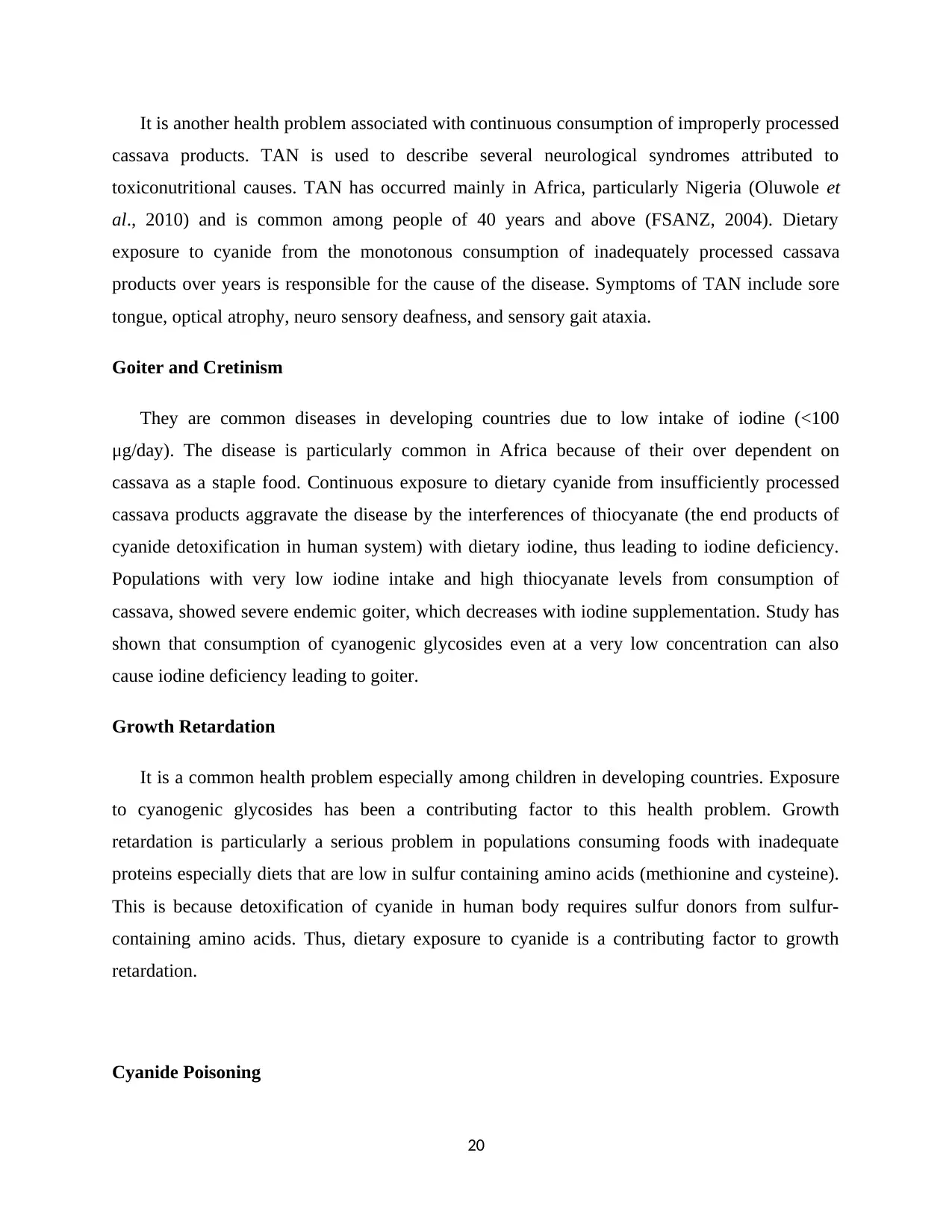
It is another health problem associated with continuous consumption of improperly processed
cassava products. TAN is used to describe several neurological syndromes attributed to
toxiconutritional causes. TAN has occurred mainly in Africa, particularly Nigeria (Oluwole et
al., 2010) and is common among people of 40 years and above (FSANZ, 2004). Dietary
exposure to cyanide from the monotonous consumption of inadequately processed cassava
products over years is responsible for the cause of the disease. Symptoms of TAN include sore
tongue, optical atrophy, neuro sensory deafness, and sensory gait ataxia.
Goiter and Cretinism
They are common diseases in developing countries due to low intake of iodine (<100
μg/day). The disease is particularly common in Africa because of their over dependent on
cassava as a staple food. Continuous exposure to dietary cyanide from insufficiently processed
cassava products aggravate the disease by the interferences of thiocyanate (the end products of
cyanide detoxification in human system) with dietary iodine, thus leading to iodine deficiency.
Populations with very low iodine intake and high thiocyanate levels from consumption of
cassava, showed severe endemic goiter, which decreases with iodine supplementation. Study has
shown that consumption of cyanogenic glycosides even at a very low concentration can also
cause iodine deficiency leading to goiter.
Growth Retardation
It is a common health problem especially among children in developing countries. Exposure
to cyanogenic glycosides has been a contributing factor to this health problem. Growth
retardation is particularly a serious problem in populations consuming foods with inadequate
proteins especially diets that are low in sulfur containing amino acids (methionine and cysteine).
This is because detoxification of cyanide in human body requires sulfur donors from sulfur‐
containing amino acids. Thus, dietary exposure to cyanide is a contributing factor to growth
retardation.
Cyanide Poisoning
20
cassava products. TAN is used to describe several neurological syndromes attributed to
toxiconutritional causes. TAN has occurred mainly in Africa, particularly Nigeria (Oluwole et
al., 2010) and is common among people of 40 years and above (FSANZ, 2004). Dietary
exposure to cyanide from the monotonous consumption of inadequately processed cassava
products over years is responsible for the cause of the disease. Symptoms of TAN include sore
tongue, optical atrophy, neuro sensory deafness, and sensory gait ataxia.
Goiter and Cretinism
They are common diseases in developing countries due to low intake of iodine (<100
μg/day). The disease is particularly common in Africa because of their over dependent on
cassava as a staple food. Continuous exposure to dietary cyanide from insufficiently processed
cassava products aggravate the disease by the interferences of thiocyanate (the end products of
cyanide detoxification in human system) with dietary iodine, thus leading to iodine deficiency.
Populations with very low iodine intake and high thiocyanate levels from consumption of
cassava, showed severe endemic goiter, which decreases with iodine supplementation. Study has
shown that consumption of cyanogenic glycosides even at a very low concentration can also
cause iodine deficiency leading to goiter.
Growth Retardation
It is a common health problem especially among children in developing countries. Exposure
to cyanogenic glycosides has been a contributing factor to this health problem. Growth
retardation is particularly a serious problem in populations consuming foods with inadequate
proteins especially diets that are low in sulfur containing amino acids (methionine and cysteine).
This is because detoxification of cyanide in human body requires sulfur donors from sulfur‐
containing amino acids. Thus, dietary exposure to cyanide is a contributing factor to growth
retardation.
Cyanide Poisoning
20
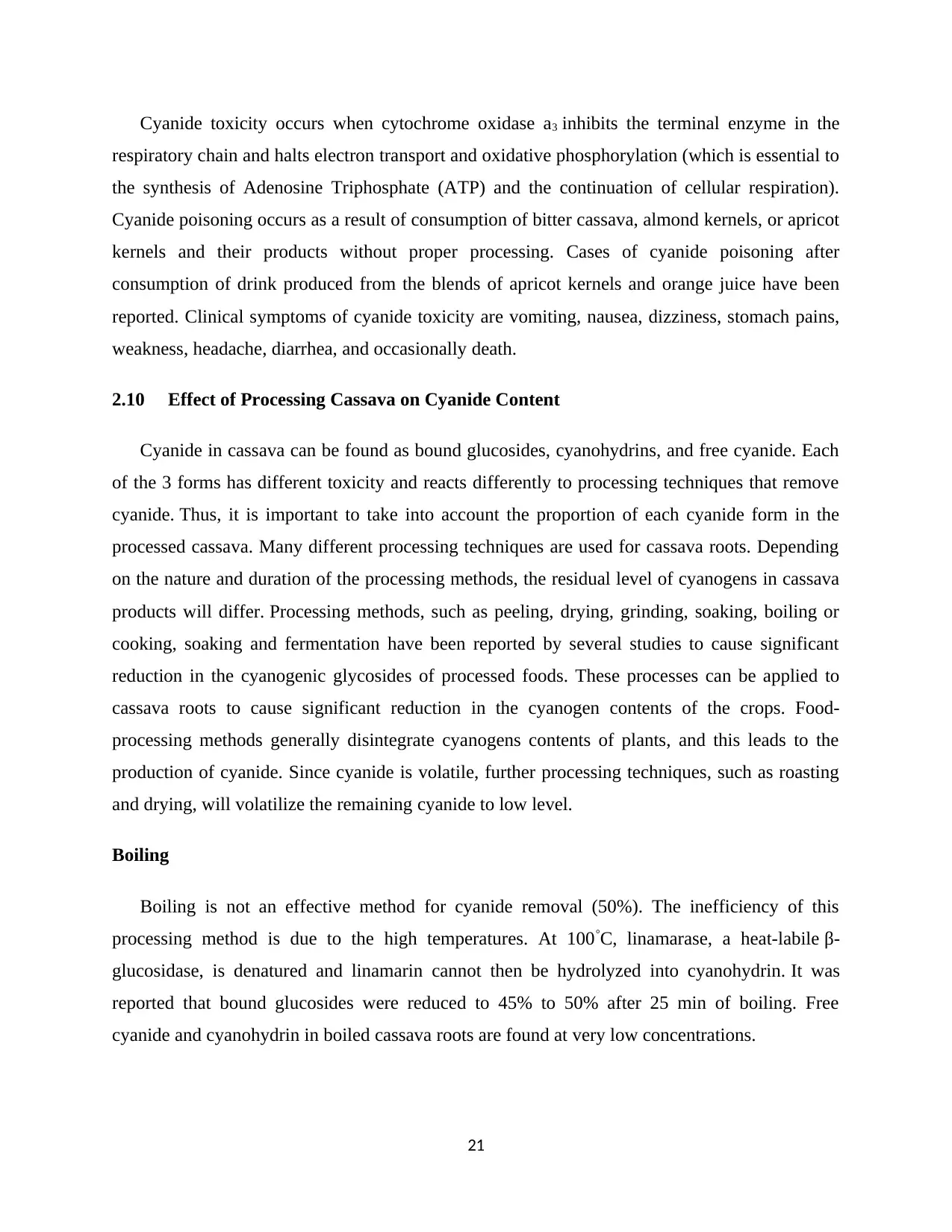
Cyanide toxicity occurs when cytochrome oxidase a3 inhibits the terminal enzyme in the
respiratory chain and halts electron transport and oxidative phosphorylation (which is essential to
the synthesis of Adenosine Triphosphate (ATP) and the continuation of cellular respiration).
Cyanide poisoning occurs as a result of consumption of bitter cassava, almond kernels, or apricot
kernels and their products without proper processing. Cases of cyanide poisoning after
consumption of drink produced from the blends of apricot kernels and orange juice have been
reported. Clinical symptoms of cyanide toxicity are vomiting, nausea, dizziness, stomach pains,
weakness, headache, diarrhea, and occasionally death.
2.10 Effect of Processing Cassava on Cyanide Content
Cyanide in cassava can be found as bound glucosides, cyanohydrins, and free cyanide. Each
of the 3 forms has different toxicity and reacts differently to processing techniques that remove
cyanide. Thus, it is important to take into account the proportion of each cyanide form in the
processed cassava. Many different processing techniques are used for cassava roots. Depending
on the nature and duration of the processing methods, the residual level of cyanogens in cassava
products will differ. Processing methods, such as peeling, drying, grinding, soaking, boiling or
cooking, soaking and fermentation have been reported by several studies to cause significant
reduction in the cyanogenic glycosides of processed foods. These processes can be applied to
cassava roots to cause significant reduction in the cyanogen contents of the crops. Food‐
processing methods generally disintegrate cyanogens contents of plants, and this leads to the
production of cyanide. Since cyanide is volatile, further processing techniques, such as roasting
and drying, will volatilize the remaining cyanide to low level.
Boiling
Boiling is not an effective method for cyanide removal (50%). The inefficiency of this
processing method is due to the high temperatures. At 100°C, linamarase, a heat-labile β-
glucosidase, is denatured and linamarin cannot then be hydrolyzed into cyanohydrin. It was
reported that bound glucosides were reduced to 45% to 50% after 25 min of boiling. Free
cyanide and cyanohydrin in boiled cassava roots are found at very low concentrations.
21
respiratory chain and halts electron transport and oxidative phosphorylation (which is essential to
the synthesis of Adenosine Triphosphate (ATP) and the continuation of cellular respiration).
Cyanide poisoning occurs as a result of consumption of bitter cassava, almond kernels, or apricot
kernels and their products without proper processing. Cases of cyanide poisoning after
consumption of drink produced from the blends of apricot kernels and orange juice have been
reported. Clinical symptoms of cyanide toxicity are vomiting, nausea, dizziness, stomach pains,
weakness, headache, diarrhea, and occasionally death.
2.10 Effect of Processing Cassava on Cyanide Content
Cyanide in cassava can be found as bound glucosides, cyanohydrins, and free cyanide. Each
of the 3 forms has different toxicity and reacts differently to processing techniques that remove
cyanide. Thus, it is important to take into account the proportion of each cyanide form in the
processed cassava. Many different processing techniques are used for cassava roots. Depending
on the nature and duration of the processing methods, the residual level of cyanogens in cassava
products will differ. Processing methods, such as peeling, drying, grinding, soaking, boiling or
cooking, soaking and fermentation have been reported by several studies to cause significant
reduction in the cyanogenic glycosides of processed foods. These processes can be applied to
cassava roots to cause significant reduction in the cyanogen contents of the crops. Food‐
processing methods generally disintegrate cyanogens contents of plants, and this leads to the
production of cyanide. Since cyanide is volatile, further processing techniques, such as roasting
and drying, will volatilize the remaining cyanide to low level.
Boiling
Boiling is not an effective method for cyanide removal (50%). The inefficiency of this
processing method is due to the high temperatures. At 100°C, linamarase, a heat-labile β-
glucosidase, is denatured and linamarin cannot then be hydrolyzed into cyanohydrin. It was
reported that bound glucosides were reduced to 45% to 50% after 25 min of boiling. Free
cyanide and cyanohydrin in boiled cassava roots are found at very low concentrations.
21
You're viewing a preview
Unlock full access by subscribing today!
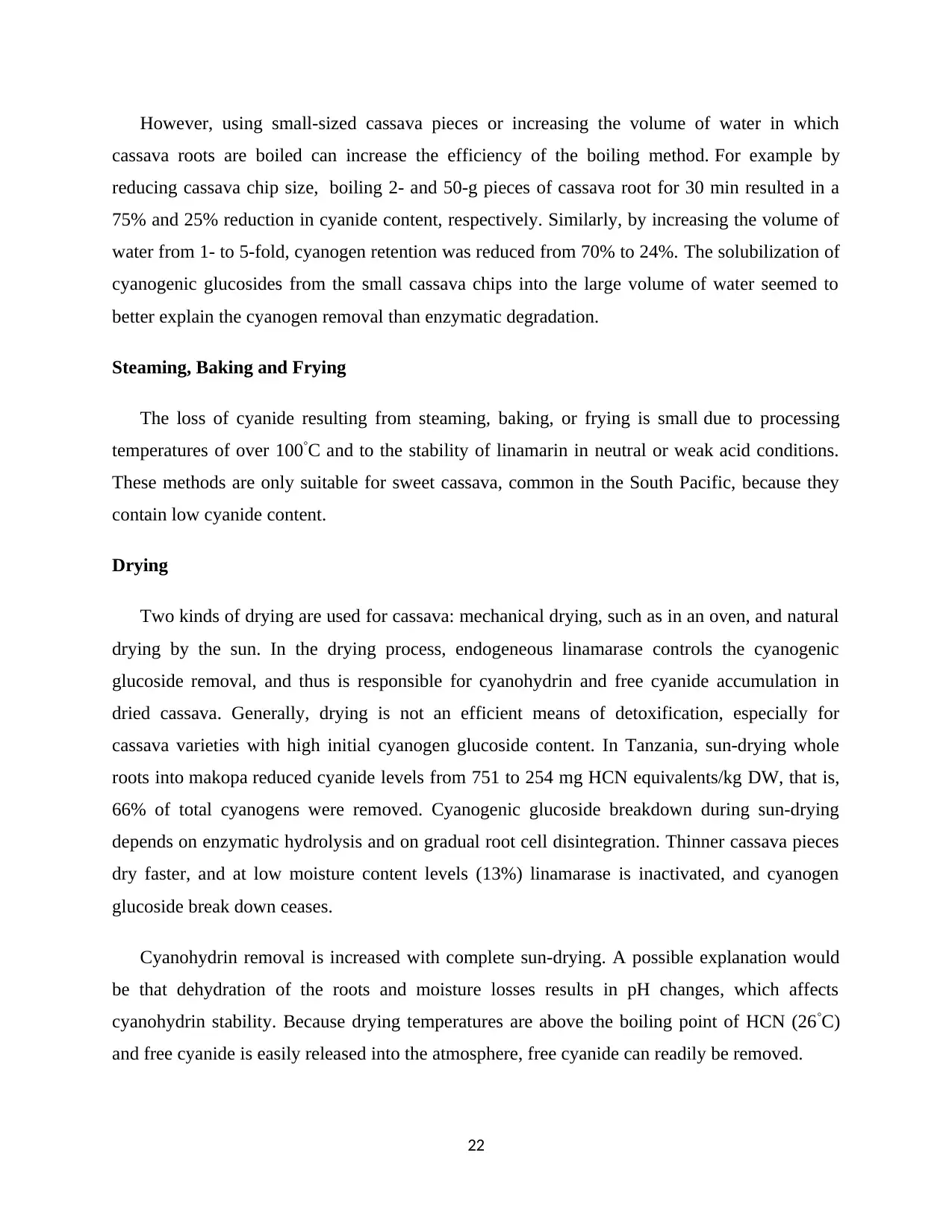
However, using small-sized cassava pieces or increasing the volume of water in which
cassava roots are boiled can increase the efficiency of the boiling method. For example by
reducing cassava chip size, boiling 2- and 50-g pieces of cassava root for 30 min resulted in a
75% and 25% reduction in cyanide content, respectively. Similarly, by increasing the volume of
water from 1- to 5-fold, cyanogen retention was reduced from 70% to 24%. The solubilization of
cyanogenic glucosides from the small cassava chips into the large volume of water seemed to
better explain the cyanogen removal than enzymatic degradation.
Steaming, Baking and Frying
The loss of cyanide resulting from steaming, baking, or frying is small due to processing
temperatures of over 100°C and to the stability of linamarin in neutral or weak acid conditions.
These methods are only suitable for sweet cassava, common in the South Pacific, because they
contain low cyanide content.
Drying
Two kinds of drying are used for cassava: mechanical drying, such as in an oven, and natural
drying by the sun. In the drying process, endogeneous linamarase controls the cyanogenic
glucoside removal, and thus is responsible for cyanohydrin and free cyanide accumulation in
dried cassava. Generally, drying is not an efficient means of detoxification, especially for
cassava varieties with high initial cyanogen glucoside content. In Tanzania, sun-drying whole
roots into makopa reduced cyanide levels from 751 to 254 mg HCN equivalents/kg DW, that is,
66% of total cyanogens were removed. Cyanogenic glucoside breakdown during sun-drying
depends on enzymatic hydrolysis and on gradual root cell disintegration. Thinner cassava pieces
dry faster, and at low moisture content levels (13%) linamarase is inactivated, and cyanogen
glucoside break down ceases.
Cyanohydrin removal is increased with complete sun-drying. A possible explanation would
be that dehydration of the roots and moisture losses results in pH changes, which affects
cyanohydrin stability. Because drying temperatures are above the boiling point of HCN (26°C)
and free cyanide is easily released into the atmosphere, free cyanide can readily be removed.
22
cassava roots are boiled can increase the efficiency of the boiling method. For example by
reducing cassava chip size, boiling 2- and 50-g pieces of cassava root for 30 min resulted in a
75% and 25% reduction in cyanide content, respectively. Similarly, by increasing the volume of
water from 1- to 5-fold, cyanogen retention was reduced from 70% to 24%. The solubilization of
cyanogenic glucosides from the small cassava chips into the large volume of water seemed to
better explain the cyanogen removal than enzymatic degradation.
Steaming, Baking and Frying
The loss of cyanide resulting from steaming, baking, or frying is small due to processing
temperatures of over 100°C and to the stability of linamarin in neutral or weak acid conditions.
These methods are only suitable for sweet cassava, common in the South Pacific, because they
contain low cyanide content.
Drying
Two kinds of drying are used for cassava: mechanical drying, such as in an oven, and natural
drying by the sun. In the drying process, endogeneous linamarase controls the cyanogenic
glucoside removal, and thus is responsible for cyanohydrin and free cyanide accumulation in
dried cassava. Generally, drying is not an efficient means of detoxification, especially for
cassava varieties with high initial cyanogen glucoside content. In Tanzania, sun-drying whole
roots into makopa reduced cyanide levels from 751 to 254 mg HCN equivalents/kg DW, that is,
66% of total cyanogens were removed. Cyanogenic glucoside breakdown during sun-drying
depends on enzymatic hydrolysis and on gradual root cell disintegration. Thinner cassava pieces
dry faster, and at low moisture content levels (13%) linamarase is inactivated, and cyanogen
glucoside break down ceases.
Cyanohydrin removal is increased with complete sun-drying. A possible explanation would
be that dehydration of the roots and moisture losses results in pH changes, which affects
cyanohydrin stability. Because drying temperatures are above the boiling point of HCN (26°C)
and free cyanide is easily released into the atmosphere, free cyanide can readily be removed.
22
Paraphrase This Document
Need a fresh take? Get an instant paraphrase of this document with our AI Paraphraser
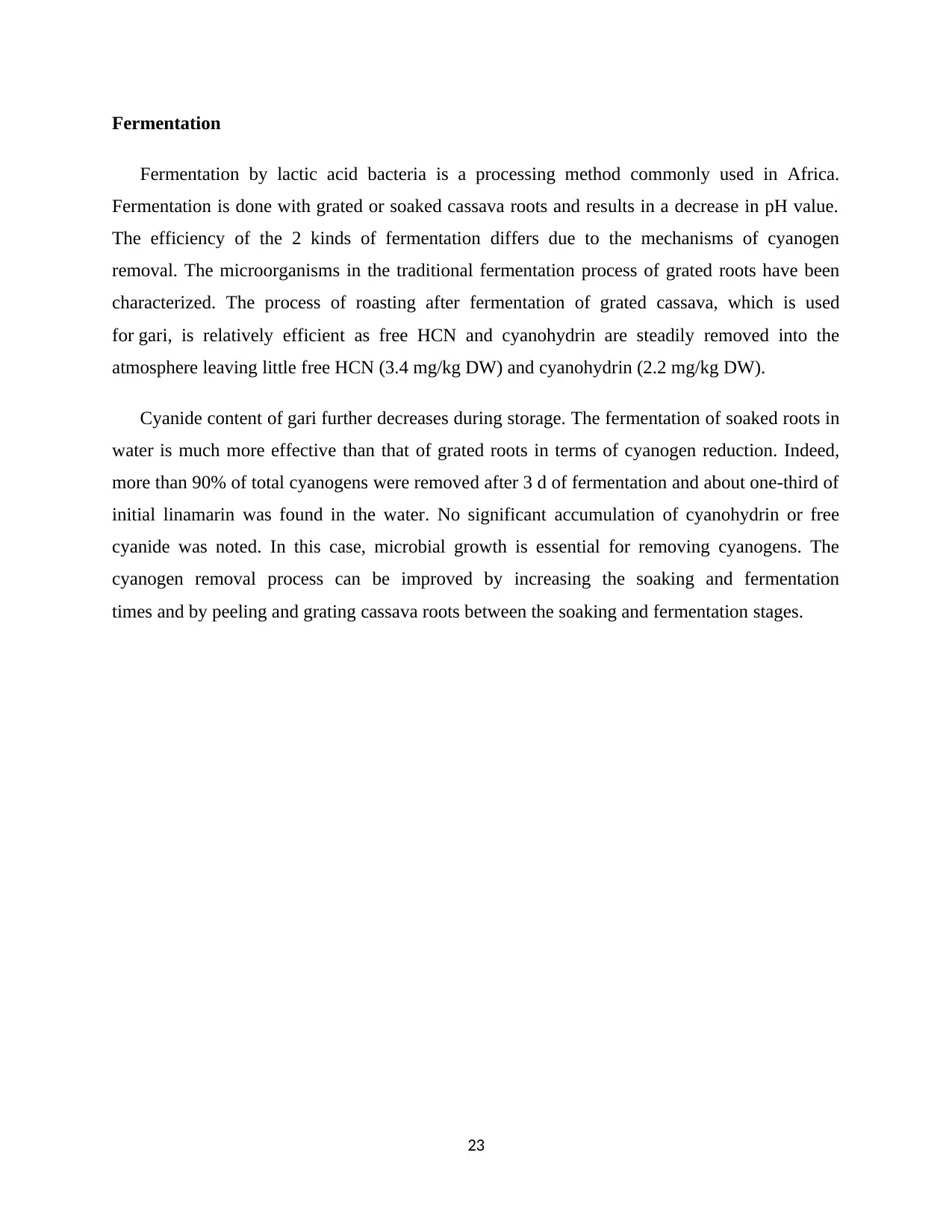
Fermentation
Fermentation by lactic acid bacteria is a processing method commonly used in Africa.
Fermentation is done with grated or soaked cassava roots and results in a decrease in pH value.
The efficiency of the 2 kinds of fermentation differs due to the mechanisms of cyanogen
removal. The microorganisms in the traditional fermentation process of grated roots have been
characterized. The process of roasting after fermentation of grated cassava, which is used
for gari, is relatively efficient as free HCN and cyanohydrin are steadily removed into the
atmosphere leaving little free HCN (3.4 mg/kg DW) and cyanohydrin (2.2 mg/kg DW).
Cyanide content of gari further decreases during storage. The fermentation of soaked roots in
water is much more effective than that of grated roots in terms of cyanogen reduction. Indeed,
more than 90% of total cyanogens were removed after 3 d of fermentation and about one-third of
initial linamarin was found in the water. No significant accumulation of cyanohydrin or free
cyanide was noted. In this case, microbial growth is essential for removing cyanogens. The
cyanogen removal process can be improved by increasing the soaking and fermentation
times and by peeling and grating cassava roots between the soaking and fermentation stages.
23
Fermentation by lactic acid bacteria is a processing method commonly used in Africa.
Fermentation is done with grated or soaked cassava roots and results in a decrease in pH value.
The efficiency of the 2 kinds of fermentation differs due to the mechanisms of cyanogen
removal. The microorganisms in the traditional fermentation process of grated roots have been
characterized. The process of roasting after fermentation of grated cassava, which is used
for gari, is relatively efficient as free HCN and cyanohydrin are steadily removed into the
atmosphere leaving little free HCN (3.4 mg/kg DW) and cyanohydrin (2.2 mg/kg DW).
Cyanide content of gari further decreases during storage. The fermentation of soaked roots in
water is much more effective than that of grated roots in terms of cyanogen reduction. Indeed,
more than 90% of total cyanogens were removed after 3 d of fermentation and about one-third of
initial linamarin was found in the water. No significant accumulation of cyanohydrin or free
cyanide was noted. In this case, microbial growth is essential for removing cyanogens. The
cyanogen removal process can be improved by increasing the soaking and fermentation
times and by peeling and grating cassava roots between the soaking and fermentation stages.
23
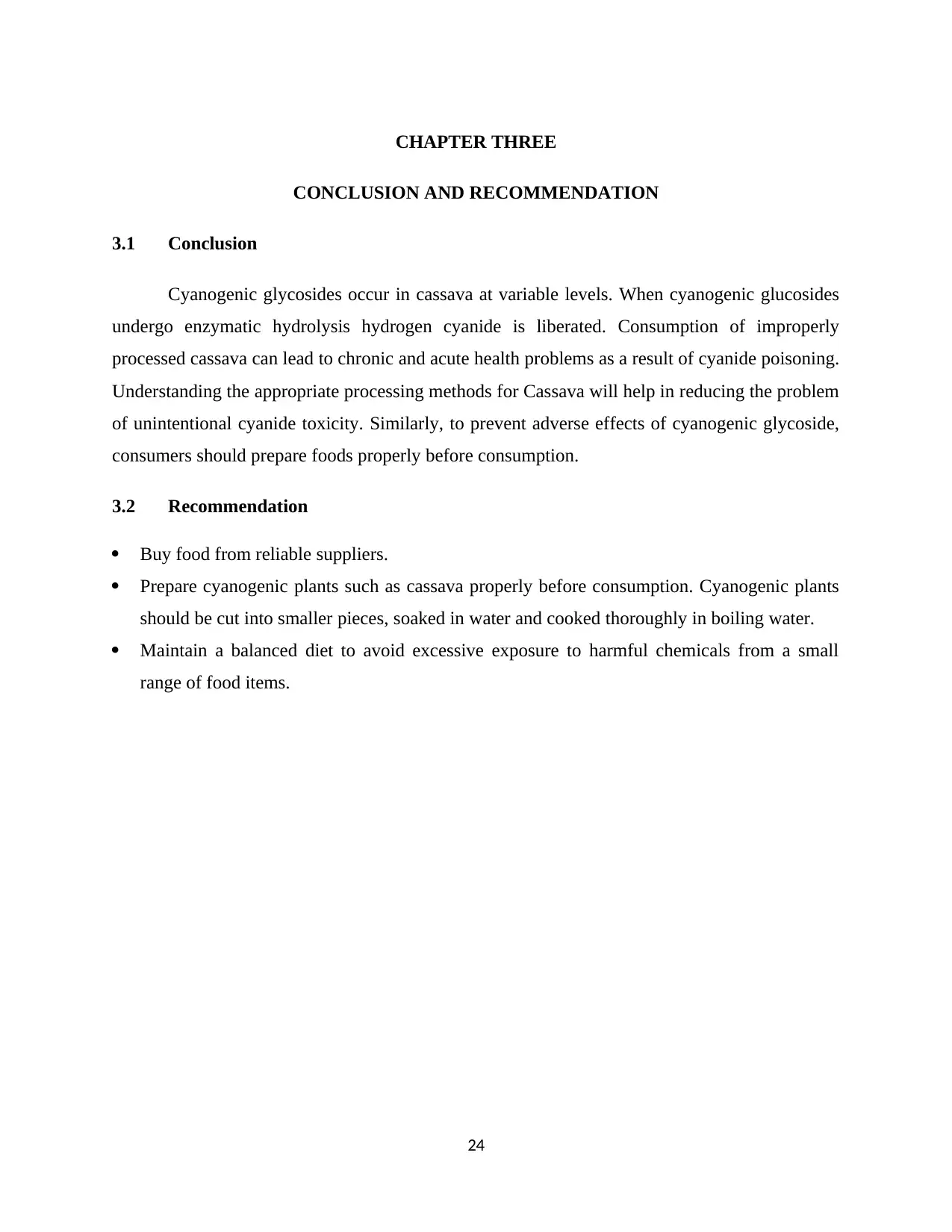
CHAPTER THREE
CONCLUSION AND RECOMMENDATION
3.1 Conclusion
Cyanogenic glycosides occur in cassava at variable levels. When cyanogenic glucosides
undergo enzymatic hydrolysis hydrogen cyanide is liberated. Consumption of improperly
processed cassava can lead to chronic and acute health problems as a result of cyanide poisoning.
Understanding the appropriate processing methods for Cassava will help in reducing the problem
of unintentional cyanide toxicity. Similarly, to prevent adverse effects of cyanogenic glycoside,
consumers should prepare foods properly before consumption.
3.2 Recommendation
Buy food from reliable suppliers.
Prepare cyanogenic plants such as cassava properly before consumption. Cyanogenic plants
should be cut into smaller pieces, soaked in water and cooked thoroughly in boiling water.
Maintain a balanced diet to avoid excessive exposure to harmful chemicals from a small
range of food items.
24
CONCLUSION AND RECOMMENDATION
3.1 Conclusion
Cyanogenic glycosides occur in cassava at variable levels. When cyanogenic glucosides
undergo enzymatic hydrolysis hydrogen cyanide is liberated. Consumption of improperly
processed cassava can lead to chronic and acute health problems as a result of cyanide poisoning.
Understanding the appropriate processing methods for Cassava will help in reducing the problem
of unintentional cyanide toxicity. Similarly, to prevent adverse effects of cyanogenic glycoside,
consumers should prepare foods properly before consumption.
3.2 Recommendation
Buy food from reliable suppliers.
Prepare cyanogenic plants such as cassava properly before consumption. Cyanogenic plants
should be cut into smaller pieces, soaked in water and cooked thoroughly in boiling water.
Maintain a balanced diet to avoid excessive exposure to harmful chemicals from a small
range of food items.
24
You're viewing a preview
Unlock full access by subscribing today!
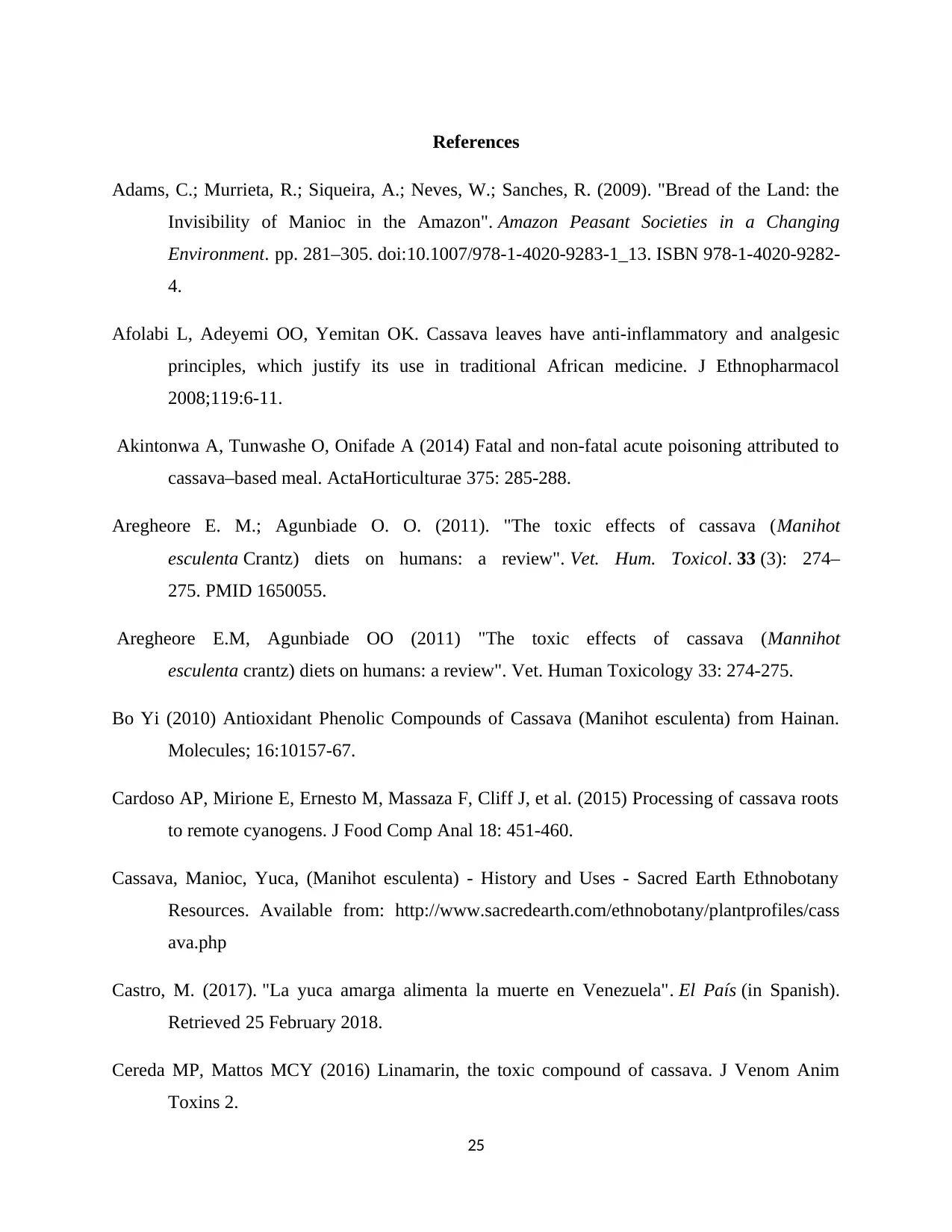
References
Adams, C.; Murrieta, R.; Siqueira, A.; Neves, W.; Sanches, R. (2009). "Bread of the Land: the
Invisibility of Manioc in the Amazon". Amazon Peasant Societies in a Changing
Environment. pp. 281–305. doi:10.1007/978-1-4020-9283-1_13. ISBN 978-1-4020-9282-
4.
Afolabi L, Adeyemi OO, Yemitan OK. Cassava leaves have anti-inflammatory and analgesic
principles, which justify its use in traditional African medicine. J Ethnopharmacol
2008;119:6-11.
Akintonwa A, Tunwashe O, Onifade A (2014) Fatal and non-fatal acute poisoning attributed to
cassava–based meal. ActaHorticulturae 375: 285-288.
Aregheore E. M.; Agunbiade O. O. (2011). "The toxic effects of cassava (Manihot
esculenta Crantz) diets on humans: a review". Vet. Hum. Toxicol. 33 (3): 274–
275. PMID 1650055.
Aregheore E.M, Agunbiade OO (2011) "The toxic effects of cassava (Mannihot
esculenta crantz) diets on humans: a review". Vet. Human Toxicology 33: 274-275.
Bo Yi (2010) Antioxidant Phenolic Compounds of Cassava (Manihot esculenta) from Hainan.
Molecules; 16:10157-67.
Cardoso AP, Mirione E, Ernesto M, Massaza F, Cliff J, et al. (2015) Processing of cassava roots
to remote cyanogens. J Food Comp Anal 18: 451-460.
Cassava, Manioc, Yuca, (Manihot esculenta) - History and Uses - Sacred Earth Ethnobotany
Resources. Available from: http://www.sacredearth.com/ethnobotany/plantprofiles/cass
ava.php
Castro, M. (2017). "La yuca amarga alimenta la muerte en Venezuela". El País (in Spanish).
Retrieved 25 February 2018.
Cereda MP, Mattos MCY (2016) Linamarin, the toxic compound of cassava. J Venom Anim
Toxins 2.
25
Adams, C.; Murrieta, R.; Siqueira, A.; Neves, W.; Sanches, R. (2009). "Bread of the Land: the
Invisibility of Manioc in the Amazon". Amazon Peasant Societies in a Changing
Environment. pp. 281–305. doi:10.1007/978-1-4020-9283-1_13. ISBN 978-1-4020-9282-
4.
Afolabi L, Adeyemi OO, Yemitan OK. Cassava leaves have anti-inflammatory and analgesic
principles, which justify its use in traditional African medicine. J Ethnopharmacol
2008;119:6-11.
Akintonwa A, Tunwashe O, Onifade A (2014) Fatal and non-fatal acute poisoning attributed to
cassava–based meal. ActaHorticulturae 375: 285-288.
Aregheore E. M.; Agunbiade O. O. (2011). "The toxic effects of cassava (Manihot
esculenta Crantz) diets on humans: a review". Vet. Hum. Toxicol. 33 (3): 274–
275. PMID 1650055.
Aregheore E.M, Agunbiade OO (2011) "The toxic effects of cassava (Mannihot
esculenta crantz) diets on humans: a review". Vet. Human Toxicology 33: 274-275.
Bo Yi (2010) Antioxidant Phenolic Compounds of Cassava (Manihot esculenta) from Hainan.
Molecules; 16:10157-67.
Cardoso AP, Mirione E, Ernesto M, Massaza F, Cliff J, et al. (2015) Processing of cassava roots
to remote cyanogens. J Food Comp Anal 18: 451-460.
Cassava, Manioc, Yuca, (Manihot esculenta) - History and Uses - Sacred Earth Ethnobotany
Resources. Available from: http://www.sacredearth.com/ethnobotany/plantprofiles/cass
ava.php
Castro, M. (2017). "La yuca amarga alimenta la muerte en Venezuela". El País (in Spanish).
Retrieved 25 February 2018.
Cereda MP, Mattos MCY (2016) Linamarin, the toxic compound of cassava. J Venom Anim
Toxins 2.
25
Paraphrase This Document
Need a fresh take? Get an instant paraphrase of this document with our AI Paraphraser
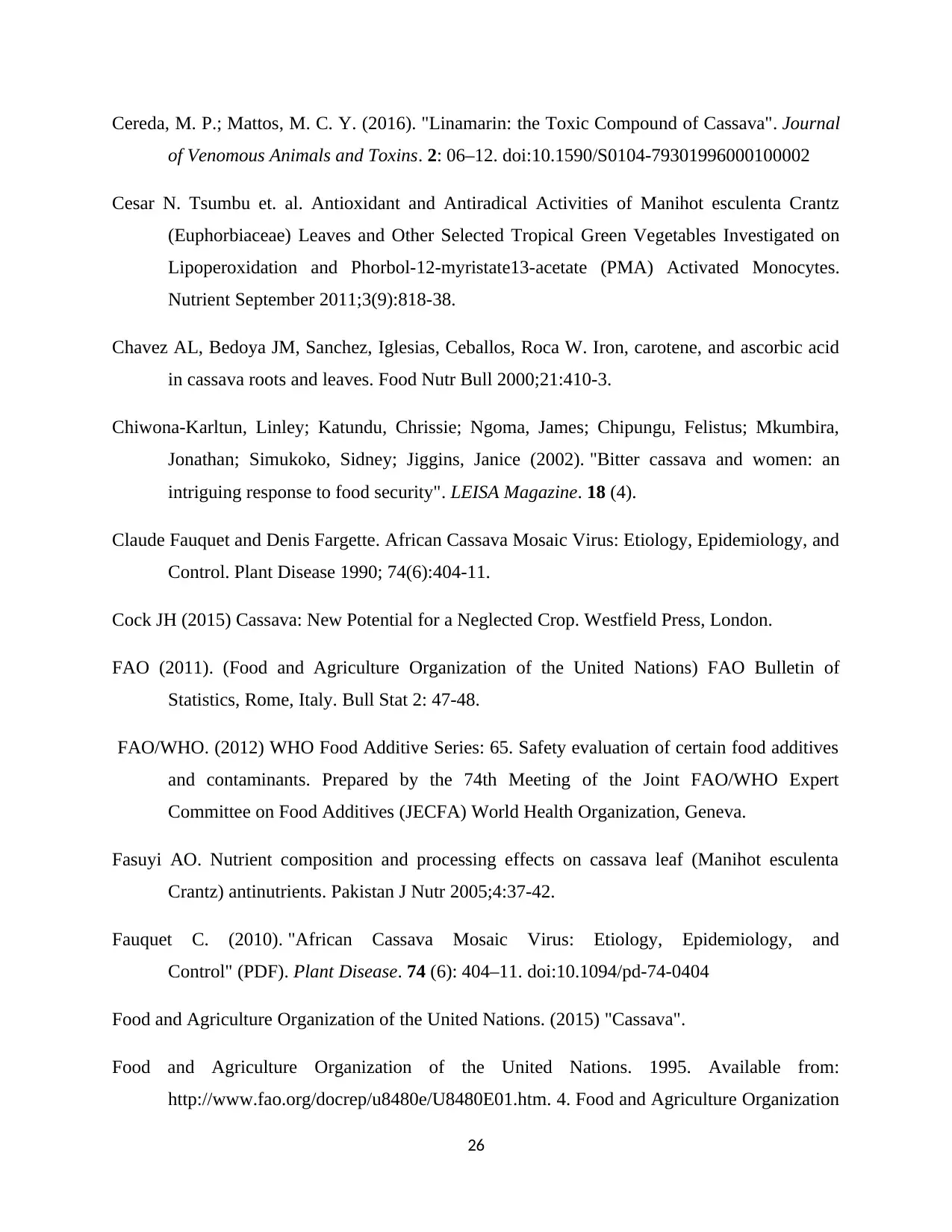
Cereda, M. P.; Mattos, M. C. Y. (2016). "Linamarin: the Toxic Compound of Cassava". Journal
of Venomous Animals and Toxins. 2: 06–12. doi:10.1590/S0104-79301996000100002
Cesar N. Tsumbu et. al. Antioxidant and Antiradical Activities of Manihot esculenta Crantz
(Euphorbiaceae) Leaves and Other Selected Tropical Green Vegetables Investigated on
Lipoperoxidation and Phorbol-12-myristate13-acetate (PMA) Activated Monocytes.
Nutrient September 2011;3(9):818-38.
Chavez AL, Bedoya JM, Sanchez, Iglesias, Ceballos, Roca W. Iron, carotene, and ascorbic acid
in cassava roots and leaves. Food Nutr Bull 2000;21:410-3.
Chiwona-Karltun, Linley; Katundu, Chrissie; Ngoma, James; Chipungu, Felistus; Mkumbira,
Jonathan; Simukoko, Sidney; Jiggins, Janice (2002). "Bitter cassava and women: an
intriguing response to food security". LEISA Magazine. 18 (4).
Claude Fauquet and Denis Fargette. African Cassava Mosaic Virus: Etiology, Epidemiology, and
Control. Plant Disease 1990; 74(6):404-11.
Cock JH (2015) Cassava: New Potential for a Neglected Crop. Westfield Press, London.
FAO (2011). (Food and Agriculture Organization of the United Nations) FAO Bulletin of
Statistics, Rome, Italy. Bull Stat 2: 47-48.
FAO/WHO. (2012) WHO Food Additive Series: 65. Safety evaluation of certain food additives
and contaminants. Prepared by the 74th Meeting of the Joint FAO/WHO Expert
Committee on Food Additives (JECFA) World Health Organization, Geneva.
Fasuyi AO. Nutrient composition and processing effects on cassava leaf (Manihot esculenta
Crantz) antinutrients. Pakistan J Nutr 2005;4:37-42.
Fauquet C. (2010). "African Cassava Mosaic Virus: Etiology, Epidemiology, and
Control" (PDF). Plant Disease. 74 (6): 404–11. doi:10.1094/pd-74-0404
Food and Agriculture Organization of the United Nations. (2015) "Cassava".
Food and Agriculture Organization of the United Nations. 1995. Available from:
http://www.fao.org/docrep/u8480e/U8480E01.htm. 4. Food and Agriculture Organization
26
of Venomous Animals and Toxins. 2: 06–12. doi:10.1590/S0104-79301996000100002
Cesar N. Tsumbu et. al. Antioxidant and Antiradical Activities of Manihot esculenta Crantz
(Euphorbiaceae) Leaves and Other Selected Tropical Green Vegetables Investigated on
Lipoperoxidation and Phorbol-12-myristate13-acetate (PMA) Activated Monocytes.
Nutrient September 2011;3(9):818-38.
Chavez AL, Bedoya JM, Sanchez, Iglesias, Ceballos, Roca W. Iron, carotene, and ascorbic acid
in cassava roots and leaves. Food Nutr Bull 2000;21:410-3.
Chiwona-Karltun, Linley; Katundu, Chrissie; Ngoma, James; Chipungu, Felistus; Mkumbira,
Jonathan; Simukoko, Sidney; Jiggins, Janice (2002). "Bitter cassava and women: an
intriguing response to food security". LEISA Magazine. 18 (4).
Claude Fauquet and Denis Fargette. African Cassava Mosaic Virus: Etiology, Epidemiology, and
Control. Plant Disease 1990; 74(6):404-11.
Cock JH (2015) Cassava: New Potential for a Neglected Crop. Westfield Press, London.
FAO (2011). (Food and Agriculture Organization of the United Nations) FAO Bulletin of
Statistics, Rome, Italy. Bull Stat 2: 47-48.
FAO/WHO. (2012) WHO Food Additive Series: 65. Safety evaluation of certain food additives
and contaminants. Prepared by the 74th Meeting of the Joint FAO/WHO Expert
Committee on Food Additives (JECFA) World Health Organization, Geneva.
Fasuyi AO. Nutrient composition and processing effects on cassava leaf (Manihot esculenta
Crantz) antinutrients. Pakistan J Nutr 2005;4:37-42.
Fauquet C. (2010). "African Cassava Mosaic Virus: Etiology, Epidemiology, and
Control" (PDF). Plant Disease. 74 (6): 404–11. doi:10.1094/pd-74-0404
Food and Agriculture Organization of the United Nations. (2015) "Cassava".
Food and Agriculture Organization of the United Nations. 1995. Available from:
http://www.fao.org/docrep/u8480e/U8480E01.htm. 4. Food and Agriculture Organization
26
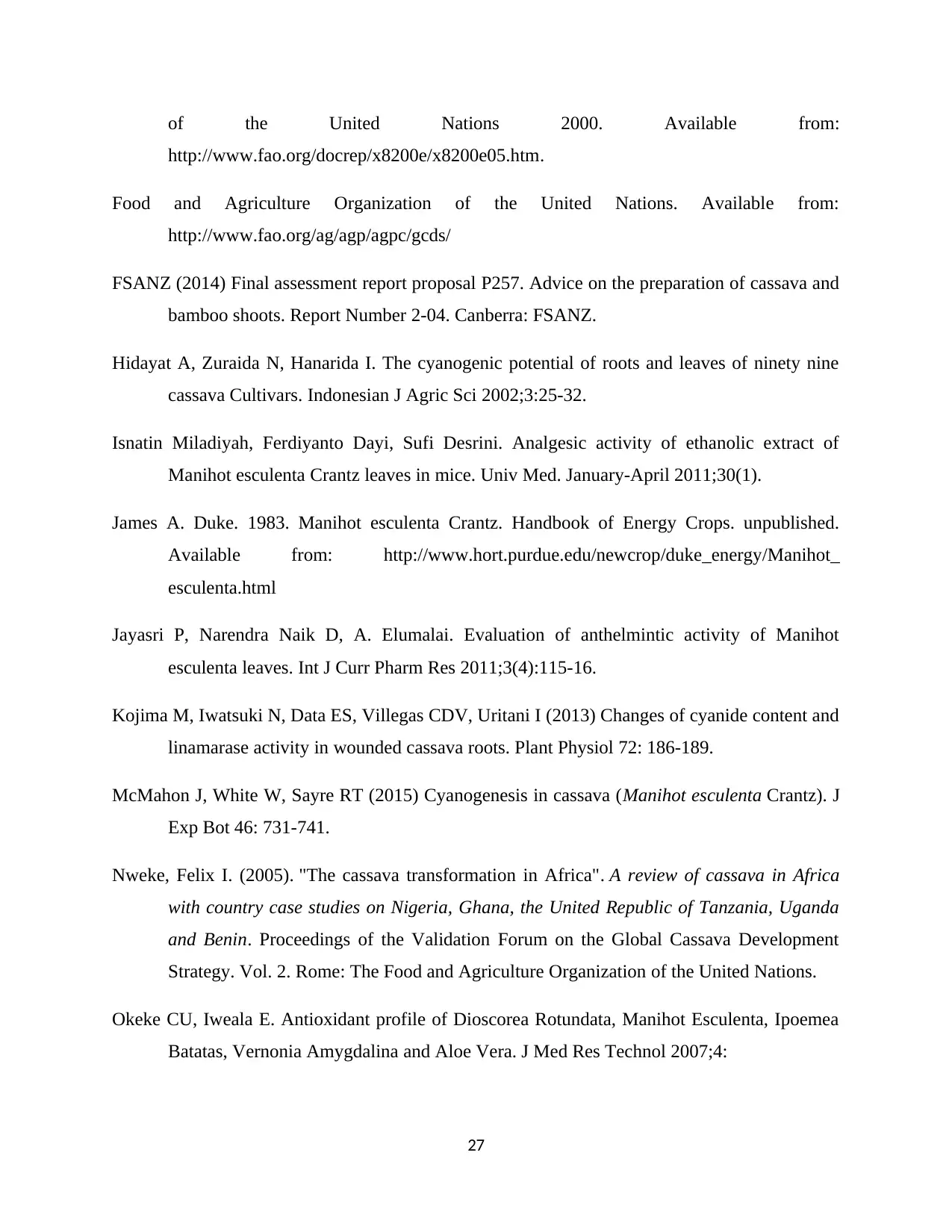
of the United Nations 2000. Available from:
http://www.fao.org/docrep/x8200e/x8200e05.htm.
Food and Agriculture Organization of the United Nations. Available from:
http://www.fao.org/ag/agp/agpc/gcds/
FSANZ (2014) Final assessment report proposal P257. Advice on the preparation of cassava and
bamboo shoots. Report Number 2-04. Canberra: FSANZ.
Hidayat A, Zuraida N, Hanarida I. The cyanogenic potential of roots and leaves of ninety nine
cassava Cultivars. Indonesian J Agric Sci 2002;3:25-32.
Isnatin Miladiyah, Ferdiyanto Dayi, Sufi Desrini. Analgesic activity of ethanolic extract of
Manihot esculenta Crantz leaves in mice. Univ Med. January-April 2011;30(1).
James A. Duke. 1983. Manihot esculenta Crantz. Handbook of Energy Crops. unpublished.
Available from: http://www.hort.purdue.edu/newcrop/duke_energy/Manihot_
esculenta.html
Jayasri P, Narendra Naik D, A. Elumalai. Evaluation of anthelmintic activity of Manihot
esculenta leaves. Int J Curr Pharm Res 2011;3(4):115-16.
Kojima M, Iwatsuki N, Data ES, Villegas CDV, Uritani I (2013) Changes of cyanide content and
linamarase activity in wounded cassava roots. Plant Physiol 72: 186-189.
McMahon J, White W, Sayre RT (2015) Cyanogenesis in cassava (Manihot esculenta Crantz). J
Exp Bot 46: 731-741.
Nweke, Felix I. (2005). "The cassava transformation in Africa". A review of cassava in Africa
with country case studies on Nigeria, Ghana, the United Republic of Tanzania, Uganda
and Benin. Proceedings of the Validation Forum on the Global Cassava Development
Strategy. Vol. 2. Rome: The Food and Agriculture Organization of the United Nations.
Okeke CU, Iweala E. Antioxidant profile of Dioscorea Rotundata, Manihot Esculenta, Ipoemea
Batatas, Vernonia Amygdalina and Aloe Vera. J Med Res Technol 2007;4:
27
http://www.fao.org/docrep/x8200e/x8200e05.htm.
Food and Agriculture Organization of the United Nations. Available from:
http://www.fao.org/ag/agp/agpc/gcds/
FSANZ (2014) Final assessment report proposal P257. Advice on the preparation of cassava and
bamboo shoots. Report Number 2-04. Canberra: FSANZ.
Hidayat A, Zuraida N, Hanarida I. The cyanogenic potential of roots and leaves of ninety nine
cassava Cultivars. Indonesian J Agric Sci 2002;3:25-32.
Isnatin Miladiyah, Ferdiyanto Dayi, Sufi Desrini. Analgesic activity of ethanolic extract of
Manihot esculenta Crantz leaves in mice. Univ Med. January-April 2011;30(1).
James A. Duke. 1983. Manihot esculenta Crantz. Handbook of Energy Crops. unpublished.
Available from: http://www.hort.purdue.edu/newcrop/duke_energy/Manihot_
esculenta.html
Jayasri P, Narendra Naik D, A. Elumalai. Evaluation of anthelmintic activity of Manihot
esculenta leaves. Int J Curr Pharm Res 2011;3(4):115-16.
Kojima M, Iwatsuki N, Data ES, Villegas CDV, Uritani I (2013) Changes of cyanide content and
linamarase activity in wounded cassava roots. Plant Physiol 72: 186-189.
McMahon J, White W, Sayre RT (2015) Cyanogenesis in cassava (Manihot esculenta Crantz). J
Exp Bot 46: 731-741.
Nweke, Felix I. (2005). "The cassava transformation in Africa". A review of cassava in Africa
with country case studies on Nigeria, Ghana, the United Republic of Tanzania, Uganda
and Benin. Proceedings of the Validation Forum on the Global Cassava Development
Strategy. Vol. 2. Rome: The Food and Agriculture Organization of the United Nations.
Okeke CU, Iweala E. Antioxidant profile of Dioscorea Rotundata, Manihot Esculenta, Ipoemea
Batatas, Vernonia Amygdalina and Aloe Vera. J Med Res Technol 2007;4:
27
You're viewing a preview
Unlock full access by subscribing today!
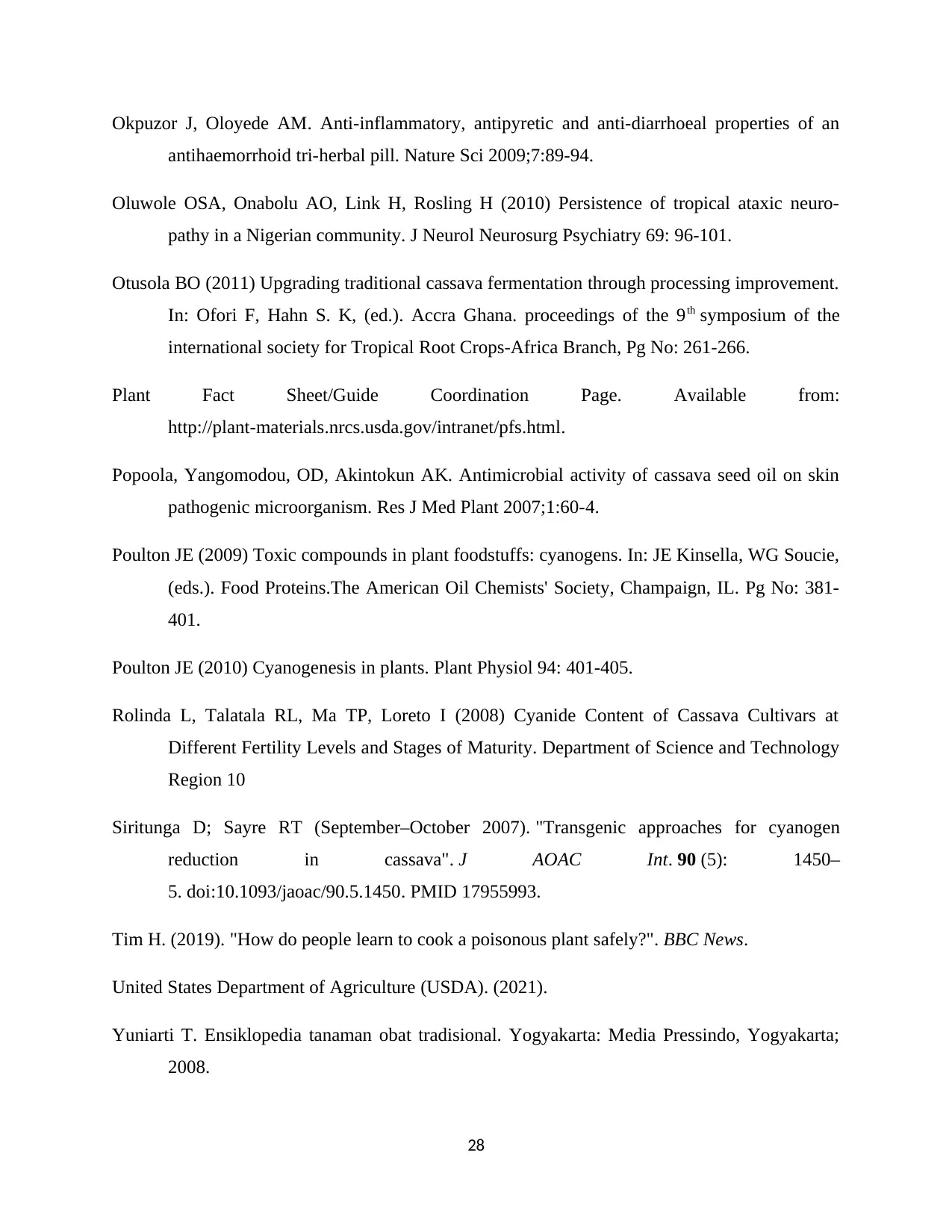
Okpuzor J, Oloyede AM. Anti-inflammatory, antipyretic and anti-diarrhoeal properties of an
antihaemorrhoid tri-herbal pill. Nature Sci 2009;7:89-94.
Oluwole OSA, Onabolu AO, Link H, Rosling H (2010) Persistence of tropical ataxic neuro‐
pathy in a Nigerian community. J Neurol Neurosurg Psychiatry 69: 96‐101.
Otusola BO (2011) Upgrading traditional cassava fermentation through processing improvement.
In: Ofori F, Hahn S. K, (ed.). Accra Ghana. proceedings of the 9th symposium of the
international society for Tropical Root Crops-Africa Branch, Pg No: 261-266.
Plant Fact Sheet/Guide Coordination Page. Available from:
http://plant-materials.nrcs.usda.gov/intranet/pfs.html.
Popoola, Yangomodou, OD, Akintokun AK. Antimicrobial activity of cassava seed oil on skin
pathogenic microorganism. Res J Med Plant 2007;1:60-4.
Poulton JE (2009) Toxic compounds in plant foodstuffs: cyanogens. In: JE Kinsella, WG Soucie,
(eds.). Food Proteins.The American Oil Chemists' Society, Champaign, IL. Pg No: 381-
401.
Poulton JE (2010) Cyanogenesis in plants. Plant Physiol 94: 401-405.
Rolinda L, Talatala RL, Ma TP, Loreto I (2008) Cyanide Content of Cassava Cultivars at
Different Fertility Levels and Stages of Maturity. Department of Science and Technology
Region 10
Siritunga D; Sayre RT (September–October 2007). "Transgenic approaches for cyanogen
reduction in cassava". J AOAC Int. 90 (5): 1450–
5. doi:10.1093/jaoac/90.5.1450. PMID 17955993.
Tim H. (2019). "How do people learn to cook a poisonous plant safely?". BBC News.
United States Department of Agriculture (USDA). (2021).
Yuniarti T. Ensiklopedia tanaman obat tradisional. Yogyakarta: Media Pressindo, Yogyakarta;
2008.
28
antihaemorrhoid tri-herbal pill. Nature Sci 2009;7:89-94.
Oluwole OSA, Onabolu AO, Link H, Rosling H (2010) Persistence of tropical ataxic neuro‐
pathy in a Nigerian community. J Neurol Neurosurg Psychiatry 69: 96‐101.
Otusola BO (2011) Upgrading traditional cassava fermentation through processing improvement.
In: Ofori F, Hahn S. K, (ed.). Accra Ghana. proceedings of the 9th symposium of the
international society for Tropical Root Crops-Africa Branch, Pg No: 261-266.
Plant Fact Sheet/Guide Coordination Page. Available from:
http://plant-materials.nrcs.usda.gov/intranet/pfs.html.
Popoola, Yangomodou, OD, Akintokun AK. Antimicrobial activity of cassava seed oil on skin
pathogenic microorganism. Res J Med Plant 2007;1:60-4.
Poulton JE (2009) Toxic compounds in plant foodstuffs: cyanogens. In: JE Kinsella, WG Soucie,
(eds.). Food Proteins.The American Oil Chemists' Society, Champaign, IL. Pg No: 381-
401.
Poulton JE (2010) Cyanogenesis in plants. Plant Physiol 94: 401-405.
Rolinda L, Talatala RL, Ma TP, Loreto I (2008) Cyanide Content of Cassava Cultivars at
Different Fertility Levels and Stages of Maturity. Department of Science and Technology
Region 10
Siritunga D; Sayre RT (September–October 2007). "Transgenic approaches for cyanogen
reduction in cassava". J AOAC Int. 90 (5): 1450–
5. doi:10.1093/jaoac/90.5.1450. PMID 17955993.
Tim H. (2019). "How do people learn to cook a poisonous plant safely?". BBC News.
United States Department of Agriculture (USDA). (2021).
Yuniarti T. Ensiklopedia tanaman obat tradisional. Yogyakarta: Media Pressindo, Yogyakarta;
2008.
28
1 out of 28
Your All-in-One AI-Powered Toolkit for Academic Success.
+13062052269
info@desklib.com
Available 24*7 on WhatsApp / Email
![[object Object]](/_next/static/media/star-bottom.7253800d.svg)
Unlock your academic potential
© 2024 | Zucol Services PVT LTD | All rights reserved.
